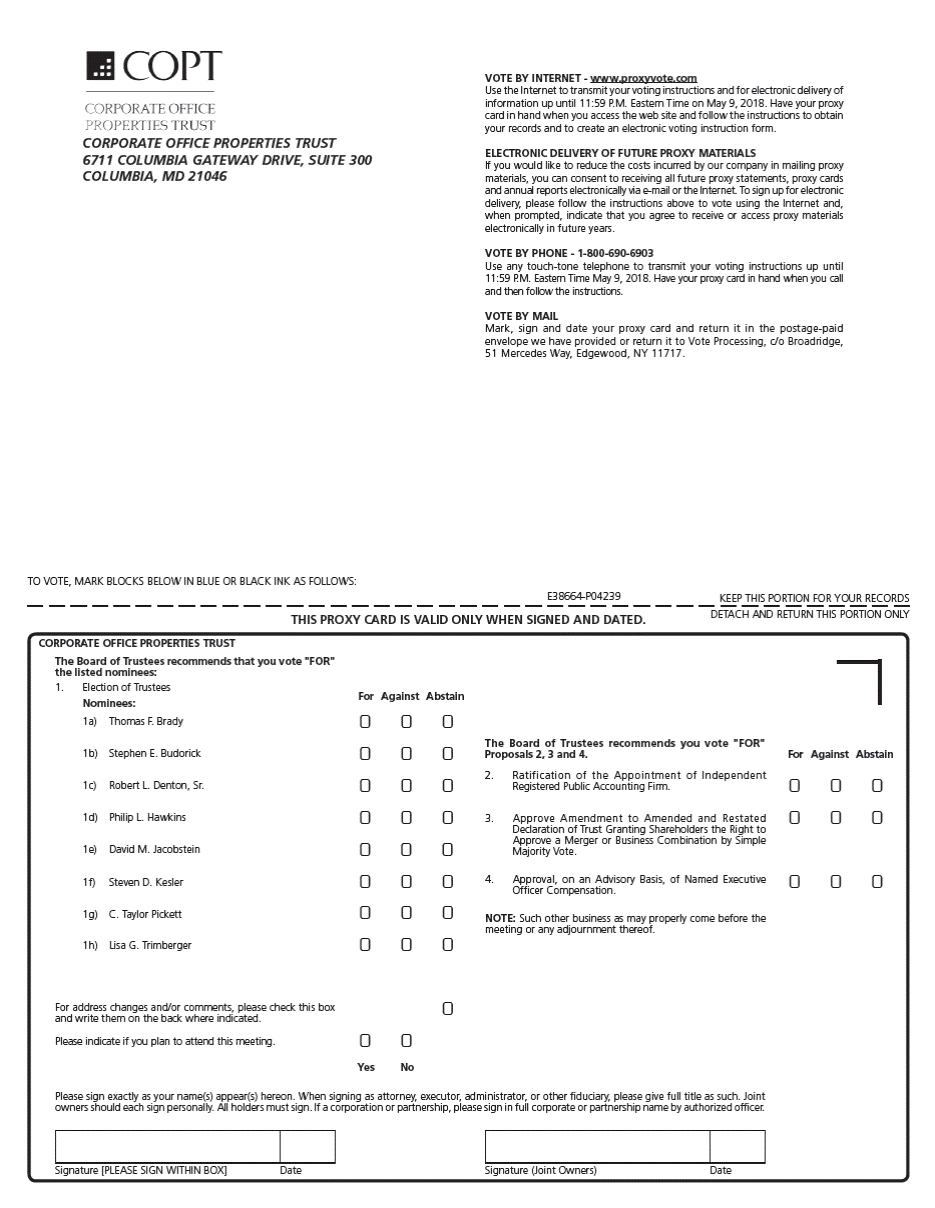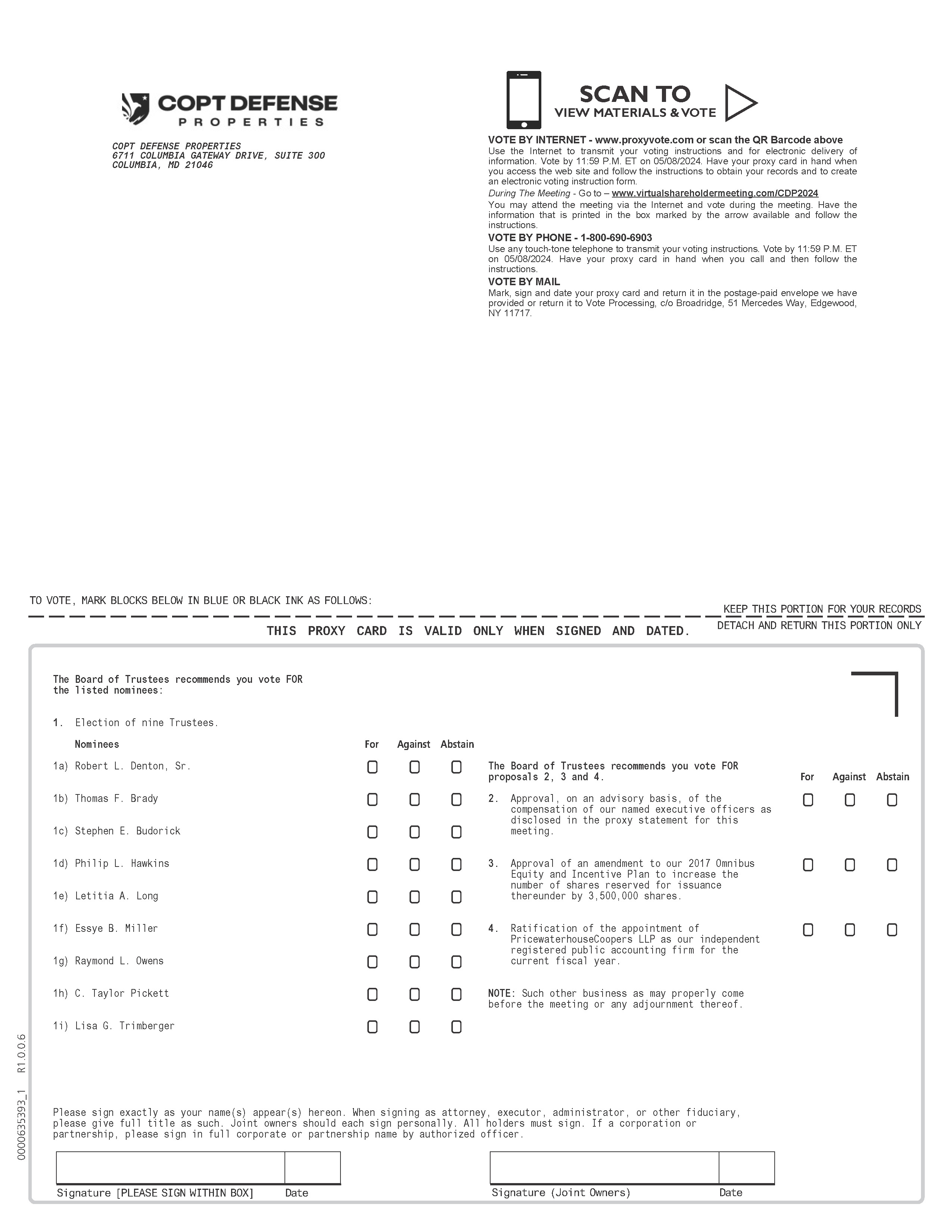SECURITIES AND EXCHANGE COMMISSION
the Securities Exchange Act of 1934 (Amendment No. )

You are cordially invited to attend our shareholders have an opportunity to participate in the Annual Meeting regardless of where they live or the number of shares they own, we will hold this year’s Annual Meeting virtually through an online webcast. current fiscal year. business and newer members who bring valuable additional attributes, skills, and experience. The of the Company; Securities and Exchange Commission (“SEC”) Regulation S-K. Chairman of the Board in advance of such meeting. If a Trustee Annual Trustee retainer Annual Chair of Board fee Annual committee chair fee Audit Compensation Investment Nominating and Corporate Governance Annual committee fees Audit Compensation Investment Nominating and Corporate Governance Fee for each Board meeting attended after first 12 per calendar year The fees set forth above units; and Thomas F. Brady Robert L. Denton, Sr. Philip L. Hawkins Elizabeth A. Hight David M. Jacobstein Steven D. Kesler C. Taylor Pickett Richard Szafranski Lisa G. Trimberger(3) trustees held outstanding stock options. activities, including oversight of cybersecurity risks. activities; and Thomas F. Brady Robert L. Denton, Sr. Philip L. Hawkins Elizabeth A. Hight David M. Jacobstein Steven D. Kesler C. Taylor Pickett Richard Szafranski Lisa G. Trimberger Meetings Held in 2017 Nominating and Corporate Governance Committee. complete anonymous governance questionnaires and self-assessments. These questionnaires and assessments facilitate a candid assessment of: (i) the Board’s performance in areas such as business strategy, risk oversight, talent development and succession planning and corporate governance; (ii) the Board’s structure, composition and culture; and (iii) the mix of skills, qualifications and experiences of our Trustees. The results of the survey are then reviewed by the Nominating and Corporate Governance Committee with the whole Board. The Nominating and Corporate Governance Committee has a policy regarding consideration of shareholder recommendations for Trustee nominees, which is set forth below: Board’s committees. in-person and most telephonic meetings of the Audit Committee. Each year, management re-evaluates the business risks covered by its ERM assessment to determine whether the proper risks are being evaluated. This assessment is then discussed with the Audit Committee and further refined with the Committee’s input. Once the ERM a period following the release of financial results for each quarter-end. The Vanguard Group(4) BlackRock, Inc.(5) Wellington Management Group LLP(6) FMR LLC(7) Thomas F. Brady Robert L. Denton, Sr.(8) Philip L. Hawkins Elizabeth A. Hight David M. Jacobstein Steven D. Kesler C. Taylor Pickett(9) Richard Szafranski Lisa G. Trimberger Stephen E. Budorick Anthony Mifsud Paul R. Adkins All Trustees and executive officers as a group (12 persons)(8) Report on Form 10-K for the year ended December 31, 2024. Audit fees(1) Audit-related fees(2) Tax fees(3) Total Stephen E. Budorick Paul R. Adkins Anthony Mifsud Stephen E. Budorick Paul R. Adkins Anthony Mifsud Financial and Operating Measures FFO per share Same property cash NOI growth Debt plus preferred equity ratio Development Leasing Volume(1) Core Portfolio Year End Occupancy Stephen E. Budorick Paul R. Adkins Anthony Mifsud Stephen E. Budorick Paul R. Adkins Anthony Mifsud Stephen E. Budorick Paul R. Adkins Anthony Mifsud Stephen E. Budorick President and Chief Executive Officer(5) Paul R. Adkins Executive Vice President and Chief Operating Officer(6) Anthony Mifsud Executive Vice President and Chief Financial Officer Stephen E. Budorick Paul R. Adkins Anthony Mifsud Stephen E. Budorick Paul R. Adkins Annual Anthony Mifsud Annual Stephen E. Budorick Paul R. Adkins Anthony Mifsud Stephen E. Budorick Paul R. Adkins Anthony Mifsud Stephen E. Budorick Premature/Constructive Termination Change in Control Death or Disability Paul R. Adkins Premature/Constructive Termination Change in Control Death or Disability Anthony Mifsud Premature/Constructive Termination Change in Control Death or Disability Equity compensation plans approved by security holders Equity compensation plans not approved by security holders TotalTableContents
6711 Columbia Gateway Drive, Suite 300Columbia, Maryland 21046-2104Telephone 443-285-5400Facsimile 443-285-7650www.copt.comNYSE: OFC

Chief Executive OfficerTo:Our ShareholdersFrom:Stephen E. BudorickSubject:Invitation to the Corporate Office Properties Trust 2018 Annual Meeting of Shareholders20182024 Annual Meeting of Shareholders to be held on May 10, 20189, 2024, at 9:30 a.m. at 6711 Columbia Gateway Drive, First Floor Sustainability Suite, Columbia, Maryland 21046,Eastern Time. To ensure each of our corporate headquarters.year'syear’s meeting, you will be asked to vote on the following:•eightnine people to our Board of Trustees;•the ratification of PricewaterhouseCoopers LLP's appointment as our independent registered public accounting firm for the current fiscal year;•approval of an amendment to the Amended and Restated Declaration of Trust granting shareholders the right to approve a merger or business combination by simple majority vote; and•meeting.The noticemeeting;annual meetingan amendment to our 2017 Omnibus Equity and proxy statement accompanying this letter contain further information about these itemsIncentive Plan to increase the number of shares reserved for issuance thereunder by 3,500,000 shares; andmeeting itself, includingratification of PricewaterhouseCoopers LLP’s appointment as our independent registered public accounting firm for the different methods you can use to vote your proxy.have elected to use theare using Securities and Exchange Commission rules that allow issuers to furnish proxy materials to their shareholders via the Internet. We believe that these rules allow us to provide our shareholders with the information they need, while lowering the costs of printing and delivery and reducing the environmental impact of our annual meeting.

![]()
President and+ Chief Executive Officer
6711 Columbia Gateway Drive, Suite 300Columbia, Maryland 21046-2104Telephone 443-285-5400Facsimile 443-285-7650www.copt.comMarch 28, 2018
of Shareholders


Date:TIME + DATEPLACE RECORD DATE
on Thursday, May 10, 20189, 2024
www.virtualshareholdermeeting.com/CDP2024March 8, 2024 Items of Business Board Recommendation How to Vote Time:1Elect nine Trustees. 9:30 a.m.

www.proxyvote.comPlace:2 Approve, on an advisory basis, the compensation of our named executive officers as disclosed in the proxy statement for this meeting. Corporate Office Properties Trust6711 Columbia Gateway DriveFirst Floor Sustainability SuiteColumbia, Maryland 21046

Scan the QR code on your proxy card, notice of internet availability of proxy materials or voting instruction form to vote with your mobile device.3 Approve an amendment to our 2017 Omnibus Equity and Incentive Plan to increase the number of shares reserved for issuance thereunder by 3,500,000 shares. 

1-800-690-6903
Call toll-free 24/74 Ratify the appointment of PricewaterhouseCoopers LLP (“PwC”) as our independent registered public accounting firm for the current fiscal year. 

Complete, sign and date your proxy card and return it in the postage-paid envelope provided.5 Transact any other business properly brought before the Annual Meeting. 
We will hold our 2018 Annual Meeting of Shareholders on May 10, 2018 at 9:30 a.m. at our corporate headquarters. During the Annual Meeting, we will consider and take action on proposals to:1.Elect eight Trustees;2.Ratify the appointment of PricewaterhouseCoopers LLP as our independent registered public accounting firm for the current fiscal year;3.Approve an amendment to the Amended and Restated Declaration of Trust granting shareholders the right to approve a merger or business combination by simple majority vote;4.Approve, on an advisory basis, the compensation of our named executive officers as disclosed in the proxy statement for this meeting; and5.Transact any other business properly brought before the Annual Meeting.12, 2018.By order of the Board of Trustees,
David L. FinchVice President, General Counsel and Secretary This proxy is being usedshareholders to permit all holdersask questions during the 2024 Annual Meeting, related rules of conduct and other materials for the 2024 Annual Meeting will be available at www.virtualshareholdermeeting.com/CDP2024.common shares of beneficial interest ("common shares") of Corporate Office Properties Trust (the "Company") to vote since many may be unable to attend the 2018 Annual Meeting of Shareholders (the "Annual Meeting") in person. Our Board of Trustees (the "Board") encourages you to read this document thoroughly and to take this opportunity to vote on the matters to be decidedby contacting Broadridge at the Annual Meeting. We will begin distribution and electronic availability of this proxy statement and proxy card on or about March 28, 2018. In accordance with the rules of the Securities and Exchange Commission (the "SEC"), instead of mailing a printed copy of our proxy materials to each shareholder of record or beneficial owner, we are furnishing our proxy materials (proxy statement for Annual Meeting, proxy card and 2017 Annual Report) by providing access to these materials on the Internet. Our shareholders will not receive printed copies of the proxy materials unless they request this form of delivery. Printed copiesphone number that will be provided upon request at no charge. A Notice of Meeting and Internet Availability of Proxy Materials ("Notice of Internet Availability") will be mailed to our shareholders on or about March 28, 2018. We are providing the Notice of Internet Availability in lieu of mailing the printed proxy materials and are instructing our shareholders as to how they may: (1) access and review our proxy materials on the Internet; (2) submit their proxy; and (3) receive printed proxy materials. Shareholders may request to receive printed proxy materials by mail or electronically by e-mail on an ongoing basis by followingwebsite for the instructions in the Notice of Internet Availability. We believe that providing future proxy materials by e-mail will save us somevirtual meeting.costs associated with printingBoard of Trustees,
Vice President, General Counsel + Secretarydelivering the materials and reduce the environmental impact of our annual meetings. A request to receive proxy materials in printed form by mail or by e-mail will remain in effect until such timevote your shares as the shareholder elects to terminate it. Our mailing address is 6711 Columbia Gateway Drive, Suite 300, Columbia, Maryland 21046-2104 and our Internet address is www.copt.com. The information on our Internet site is not part of this proxy statement.PageNumberGeneral Information3Page
NumberSection 16(a) Beneficial Ownership Reporting Compliance19SHAREHOLDERS WILL BE VOTING ON THE FOLLOWING MATTERS: Agenda Item Voting Recommendation More Information 1. Report2. 20223. Independent Registered Public Accounting Firm22464. 2354Proposal 3—Approval of Amendment to the Amended and Restated Declaration of Trust Granting Shareholders the Right to Approve a Merger or Business Combination by Simple Majority Vote23Proposal 4—Advisory Vote to Approve Executive Compensation24Compensation Committee Interlocks and Insider Participation25Report of the Compensation Committee25Compensation Discussion and Analysis26Compensation and Risk41Summary Compensation Table42All Other Compensation432017 Grants of Plan—Based Awards44Outstanding Equity Awards at December 31, 201745Stock Vested in 201746Nonqualified Deferred Compensation46Potential Payments on Termination, Change in Control, Death or Disability47Equity Compensation Plan Information49Annex A—Amendment to Amended and Restated Declaration of TrustA-1
TRUSTEE NOMINEESTableBoard Committees Age Trustee Since Audit Compensation Investment Nominating and Corporate Governance 
71 1999 



74 2002 



63 2016 
68 2014 


65 2020 


60 2022 


65 2021 


62 2013 


63 2017 


Chair 
Member 
2024 Proxy Statement 1 ContentsWhatsubstantially pre-leased properties under development at year end;
Shareholders will have the opportunity at our 2024 Annual Meeting of Shareholders to cast an advisory vote on the compensation of our named executive officers (“NEOs”) as disclosed in this proxy statement, which is referred to as a “say-on-pay proposal.” At our 2023 Annual Meeting of Shareholders, our shareholders overwhelmingly approved our say-on-pay proposal, casting 97.7% of the votes in favor of the proposal. Our Compensation Committee believes that our shareholders’ substantial approval indicated strong support for our approach to executive compensation. The Committee considers shareholder feedback and the outcome of our shareholder say-on-pay proposal votes when making future NEO compensation decisions. 2 COPT Defense Properties 
votingcommensurate to the compensation levels of executives performing similar responsibilities for an appropriate group of peer companies; andAnnual Meeting?1.The electionbeginning of eight Trustees.2.The ratification ofeach year, approved by the appointment of PricewaterhouseCoopers LLP asCompensation Committee, and set forth in our independent registered public accounting firm (the "Independent Auditor"annual corporate scorecard; andfor the current fiscal year.3. approval of an amendment to the Amended and Restated Declaration of Trust granting shareholders the right to approve a merger or business combination by simple majority vote.4.The approval, on an advisory basis, of the compensation of our named executive officersNEOs is predominantly performance-based, including AIAs and LTIP awards that are subject to objective performance thresholds, as disclosed in this proxy statement.5.Any other business that properly comes before the Annual Meeting for a vote.Who is entitled to vote at the Annual Meeting and how many votes do they have? Common shareholders of record at the close of business on March 12, 2018 may vote at the Annual Meeting. Each share has one vote. There were 101,479,775 common shares outstanding on March 2, 2018.How do I vote? You must be present, or represented by proxy, at the Annual Meeting in order to vote your shares. Since many of our shareholders are unable to attend the Annual Meeting in person, we send the Notice of Internet Availability and, if requested, proxy cards to enable all of our shareholders to vote.What is a proxy? A proxy is a person you appoint to vote on your behalf. If you vote by Internet, telephone or proxy card, your shares will be voted by the identified proxies. You can vote in one of three ways:1.By Internet. To vote using the Internet, go to the website listed on your Notice of Internet Availability or proxy card. You will need to follow the instructions on that website.2.By telephone. To vote by telephone, call the toll free number listed on your Notice of Internet Availability or proxy card. You will need to follow the instructions and the prompts from the telephone voting system.3.By mail. If you requested printed proxy materials and wish to vote by mail, simply mark, sign and date the proxy card and return itreflected in the postage-paid envelope provided. If you vote by Internet or telephone, you should not return your proxy card. If you hold your shares throughgraphic below:


2024 Proxy Statement 3 broker, bank or other nominee, you will receive separate instructions fromhigh value on our Investor Relations function, as we routinely engage with existing and prospective shareholders and sell-side analysts throughout the nominee describing howyear in a variety of forums. In 2023, we held nearly 100 meetings, amounting to vote your shares.How will my proxies vote my shares? Your proxies will vote according to your voting instructions. If you provide voting instructions but the instructions you provide do not indicate your vote on business matters, your proxies will vote as follows:•"FOR" each of the nominees for Trustee listed in Proposal 1;•"FOR" the ratification of the appointment of PricewaterhouseCoopers LLP as our Independent Auditor for the current fiscal year;•"FOR" the amendment to the Amendedapproximately 250 touchpoints with investors and Restated Declaration of Trust granting shareholders the right to approve a merger or business combination by simple majority vote; and•"FOR" approval, on an advisory basis, of the compensation of our named executive officers as disclosed in this proxy statement. We do not intend to bring any other matter for a vote at the Annual Meeting, and we do not know of anyone else who intends to do so. However, your proxies are authorized to vote on your behalf, in their discretion, on any other business that properly comes before the Annual Meeting.How do I revoke my proxy? You may revoke your proxy at any time before your shares are voted at the Annual Meeting by:•Notifying our Vice President, General Counsel and Secretary, David L. Finch, in writing at our mailing address set forth on the first page of this proxy statement, that you are revoking your proxy;•Executing a later-dated proxy card (which automatically revokes the earlier proxy card);•If previous instructions were given through the Internet or by telephone, by providing new instructions by the same means; or•Attending and voting by ballot at the Annual Meeting.Who will count the votes? An officer of Corporate Office Properties Trust will act as the Inspector of Election and will count the votes.What constitutes a quorum? As of March 2, 2018, Corporate Office Properties Trust had 101,479,775 common shares outstanding. A majority of the outstanding shares present or represented by proxy constitutes a quorum. If you complete the voting process by Internet or telephone or sign and return your proxy card, your shares will be counted in determining the presence of a quorum, even if you abstain or otherwise withhold your vote. If a quorum is not present at the Annual Meeting, the shareholders presentsell-side analysts in person or by proxy may adjournvirtually. Notably, we held our first Investor Day event in over a decade, which featured management presentations and a property tour of three of our business parks; this event enabled us to provide in-depth explanations regarding our corporate strategy, demand drivers, growth outlook and the meetingsecure nature of our portfolio, and highlight the depth of our team. We also participated in a variety of investor events, including the National Association of Real Estate Investment Trust (“Nareit”) REITweek and REITworld conferences in June and November 2023, five sell-side analyst conferences and several individual meetings and property tours.date not more than 120 days after March 12, 2018 until a quorum is present.What vote is requiredresilient and efficient portfolio that benefits our tenants and our shareholders. Our governance structure positions the Board to elect Trustees? Our Bylaws provide that,oversight with respect to the Company’s environmental risks.
Received Green Star recognition from GRESB for the ninth consecutive year. 
Further refined the Company’s climate risk assessment aligning with the Task Force on Climate-related Financial Disclosures (“TCFD”) identifying our strategy, risk management, metrics and targets, and opportunities. 
Reported information with respect to the Company’s risks and emissions data to align with applicable frameworks under both SASB and Global Reporting Initiative. 
Reported on our contribution to 13 of the 17 United Nations Sustainable Development Goals in our Corporate Sustainability Report. 4 COPT Defense Properties 
ELECTION OF NINE TRUSTEES 
recommends
a vote FOR
each of the
nine Trustee
nominees.Our Bylaws provide for the annual election of Trustees at the Annual Meeting of Shareholders. Our Board, at the recommendation of its Nominating and Corporate Governance Committee, has nominated nine of our current Trustees for election at the Annual Meeting. Each nominee has agreed to serve a one-year term. If any nominee is unable to stand for election, the Board may provide for a lesser number of Trustees or designate a substitute. In the latter event, shares represented by proxies will be voted for a substitute nominee. is elected only if such nominee receivesmust receive the affirmative vote of athe majority of the total votes cast for and against such nominee. The majority voting standard woulddoes not apply in contested elections. The majority voting standard will apply to the election of Trustees at the Annual Meeting. Accordingly, a nominee for Trustee will be elected if such nominee receives the affirmative vote of a majority of the total votes cast for and against such nominee. Broker non-votes, if any, and abstentions will not be treated as votes cast for or against the election of a Trustee. Our Board of Trustees has also adopted a resignation policy which is included in our Bylaws, under which anominee for Trustee nominated for re-election who fails to receive the required number of votes for re-election will tender his or her resignation to our Board of Trustees for its consideration. TheNominating and Corporate Governance Committee will act on an expedited basis to determine whether it is advisable to accept the Trustee's resignation and will submit the recommendation for prompt consideration by our Board. Our Board will act on the tendered resignation within 90 days following certification of the shareholder vote and will promptly and publicly disclose its decision. The Trustee whose resignation is under consideration will abstain from participating in any decision regarding his or her resignation. If the resignation is not accepted, the Trustee will continue to serve until the next annual meeting of shareholders and until the Trustee's successor is duly elected and qualified or until the Trustee's earlier resignation or removal. The Nominating and Corporate Governance Committee and our Board may consider any factors they deem relevant in deciding whether to accept a Trustee's resignation.What vote is required on other matters? In general, a majority of the votes cast at a meeting of shareholders is required to approve any other matter unless a greater vote is required by law or by the Company's Declaration of Trust. With respect to the Proposals to be voted on at the Annual Meeting, the required votes are as follows: for Proposals 2 and 4, a majority of the votes cast on each of these proposals will be required to approve each of the proposals; for Proposal 3, the affirmative vote of at least two-thirds of all the votes entitled to be cast on such proposal is required to approve such proposal. See "How Will My Vote Be Counted" for more detail on the treatment of abstentions and "broker non-votes" on Proposals 2, 3 and 4.What is a broker non-vote? A "broker non-vote" occurs when a nominee (such as a custodian or bank) holding shares for a beneficial owner returns a signed proxy but does not vote on a particular proposal because the nominee does not have discretionary voting power with respect to that item and has not received instructions from the beneficial owner.How will my vote be counted? With respect to Proposal 1, the election of Trustees, votes may be cast for or against each nominee. You may also abstain with respect to each nominee. Because abstentions and broker non-votes are not considered votes cast, they will have no effect on the outcome of the vote on election of Trustees. With respect to each of Proposals 2 and 4, you may abstain, and your abstention will have no effect on the outcome of the vote, because no vote will have been castvote. Additional information with respect to your shares. Broker non-votes will have no effect onvoting procedures and the outcomeelection of Proposals 2 and 4, because no vote will have been cast with respect to your shares. With respect to Proposal 3, abstentions and broker non-votes will have the same effect as a vote against the proposal.What percentage of our common shares do the Trustees and executive officers own? Our Trustees and executive officers owned less than 1.0% of our outstanding common shares as of March 2, 2018. Our Trustees and executive officers beneficially ownedare available in the aggregate approximately 0.6% of our common shares as of March 2, 2018 (see the discussion under the heading "Share Ownership of our Trustees, Executive OfficersQuestions and 5% Beneficial Owners" for more details).Who is soliciting my proxy, how is it being solicited and who pays the cost? Our Board is soliciting your proxy. The solicitation process is being conducted primarily by mail. However, proxies may also be solicited in person, by telephone or facsimile. Broadridge Financial Solutions, Inc., our proxy distribution and tabulation agent, will be assisting us for a fee of approximately $31,000 plus out-of-pocket expenses. We pay any cost incurred for soliciting proxies and also reimburse stockbrokers and other custodians, nominees and fiduciaries for their reasonable out-of-pocket expenses for forwarding proxy and solicitation material to the owners of common shares.Important Notice Regarding the Availability of Proxy Materials for the Annual Meeting of Shareholders to be Held on May 10, 2018 The proxy materials are available at www.copt.com under "Investor Relations," under the subheading "Annual Meeting and Proxy Materials."When are shareholder proposals and Trustee nominations for our 2019 Annual Meeting due? In accordance with our Bylaws, notice relating to nominations for Trustees or proposed business to be considered at the 2019 Annual Meeting must be given no earlier than February 9, 2019, and no later than March 11, 2019. These requirements do not affect the deadline for submitting shareholder proposals for inclusion in the proxy statement for the 2019 Annual Meeting (discussed in the question and answer below), nor do they apply to questions a shareholder may wish to ask at that meeting.When are shareholder proposals intended to be included in the proxy statement for the 2019 Annual Meeting due? Shareholders who wish to include proposals in the proxy statement must submit such proposals in accordance with regulations adopted by the Securities and Exchange Commission. Shareholder proposals for the 2019 Annual Meeting must be submitted in writing by November 28, 2018. In addition, shareholders may wish to have a proposal presented at the 2019 Annual Meeting but not to have such proposal included in the proxy statement for the 2019 Annual Meeting. Pursuant to our Bylaws, notice of any such proposal must be received by us between February 9, 2019, and no later than March 11, 2019. If it is not received during this period, such proposal shall be deemed "untimely" for purposes of Rule 14a-4(c) under the Exchange Act, and, therefore, the proxies will have the right to exercise discretionary voting authority with respect to such proposal. Any shareholder proposals must be submitted to David L. Finch, Vice President, General Counsel and Secretary, at our mailing address set forth on the front pageAnswers section of this proxy statement. You should submit any proposal byThe term of Steven D. Kesler, a method that permits you to prove the date of delivery to us.How can interested parties send communications to the Board? Any interested parties who wish to communicate with the membersmember of our Board may communicate with the independent Trustees or the chairperson of any of the committees of the Board by e-mail or regular mail. Communications by e-mail should be sent to david.finch@copt.com. Communications by regular mail should be sent to the attention of the Chairperson, Audit Committee; Chairperson, Compensation Committee; Chairperson, Nominating and Corporate Governance Committee; Chairperson, Investment Committee; or, for communications intended for the independent Trustees as a group, to the Independent Trustees. In each case, the communication should be sent care of David L. Finch, Vice President, General Counsel and Secretary, at our mailing address set forthsince September 1998, will expire on the front page of this proxy statement. All communications received in accordance with this process will be reviewed by management to determine whether the communication requires immediate action. Management will transmit allcommunications received, or a summary of such communications, to the appropriate Trustee or Trustees. However, management reserves the right to disregard any communication that it determines is unduly hostile, threatening, illegal, does not reasonably relate to us or our business or is similarly inappropriate, and has the authority to discard or disregard any inappropriate communications or to take other appropriate actions with respect to any such inappropriate communications.How can interested parties obtain information regarding our Corporate Governance Guidelines? Our Board has adopted Corporate Governance Guidelines that set forth our policies concerning overall governance practices. These Guidelines can be found in the investor relations section of our Internet website in the subsection entitled "Corporate Governance." Our Internet website address is www.copt.com. Our Corporate Governance Guidelines are also available in print to any shareholder upon request. To the extent modifications are made to our Corporate Governance Guidelines, such modifications will be reflected on our Internet website.Proposal 1—Election of Trustees Our Bylaws provide for the annual election of TrusteesMay 9, 2024 at the Annual Meeting, of Shareholders. and he will not stand for re-election.at the recommendationrepresents a balance of its Nominating and Corporate Governance Committee, has nominated eightlonger-tenured members with in-depth knowledge of our current Trustees for re-election at the Annual Meeting. Each nominee has agreed to serve a one-year term. If any of the nominees is unable to stand for election, the Board may provide for a lesser number of Trustees or designate a substitute. In the latter event, shares represented by proxies will be voted for a substitute nominee. following biographies set forth certain information with respect to the nominees for election as Trustees, all of whom currently serve as Trustees who have been nominated by the Board and are standing for re-election. These descriptions include, in the second paragraph of each, the specific experience, qualifications, attributes, and skills that led the Board to nominate each of themTrustees for re-election. The terms of U.S. Rear Admiral (Ret.) Elizabeth A. Hight, a member ofelection are set forth in their bios below. We have been regularly refreshing our Board, since February 2011, and Richard Szafranski, a member of our Board since August 2009, both expire on May 10, 2018 at the Annual Meeting, and RADM Hight and Mr. Szafranski will not be standing for re-election.Thomas F. Brady, 68, has been Chairman of our Board since May 2013 and has been a member of our Board since January 2002. Since 2009, he has advised Opower, Inc. and served as Chairmanwith three of the Opower Advisory Board until 2016. Opower, foundednominated Trustees having joined within the last four years. We believe this activity aligns the Board’s composition to our long-term strategy and broadens the Board’s perspectives to enhance its performance. Effective January 1, 2024, and in 2007 and publicly listedanticipation of Mr. Brady’s retirement in 2014 (NYSE: OPWR), now part of Oracle Corporation (NYSE:ORCL), is2025 pursuant to our Corporate Governance Guidelines, we appointed a leading provider of customer engagement and energy efficiency cloud-based software to the utility industry. He is the formernew Chairman of the Board, of Directors of Baltimore Gas & Electric Company ("BGE")further refreshing our governance and Executive Vice President-Corporate Strategy at Constellation Energy Group ("CEG") (NYSE: CEG), a position he assumed in 1999. Prior to 1999, Mr. Brady held various positions at BGE, including Vice PresidentBoard. Through continued refreshment and Chief Accounting Officer. Prior to its acquisition by Exelon, CEG was a Fortune 200 company owning energy related businesses, including BGE. BGE is the largest electrictrustee succession planning and gas utility in Maryland. Mr. Brady continued to serve on the Board of Directors of BGE through 2012. He previously served as: a Trustee and Treasurer of the Board of Stevenson University; Chairman of the Maryland Public Broadcasting Commission and Maryland Public Television; and a member of the Board of Directors of the Maryland Chamber of Commerce. Mr. Brady received a BS in Accounting from the University of Baltimore and an MBA in finance from Loyola University, completed an Advanced Executive Program at Penn State University and was a Certified Public Accountant. Mr. Brady's extensive career in key financial and strategic executive positions at a larger public company, and experiences with privately-owned, venture capital funded start-up companies, qualifies him to leaddevelopment, we believe that our Board and assess our strategic initiatives, both qualitatively and quantitatively.
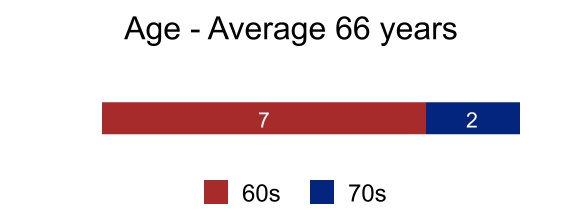
Table

2024 Proxy Statement 5 ContentsMr. Brady's utility operations experience and significant civic involvement also complement and enhance the perspectives which he brings to his role as ChairmanTrusteesTrustee Skills and Experience Robert L. Denton, Sr. Thomas F. Brady Stephen E. Budorick Philip L. Hawkins Letitia A. Long Essye B. Miller Raymond L. Owens C. Taylor Pickett Lisa G. Trimberger 
Executive Leadership 







Public Company Board Service 






Financial Literacy/Accounting 








Finance/Capital Markets 






Risk Management 



Corporate Governance 






Real Estate Investment 





Strategic Planning + Leadership 









Technology/Cybersecurity Experience 


Government/Regulatory Affairs 


Audit Committee Financial Expert 

6 COPT Defense Properties 
the Board.Stephen E. Budorick, 57, was appointed President & Chief Executive Officer on May 12, 2016. On the same date he was appointedTrusteesCOPTnominees for election as Trustees, including professional experience, Board of Trustees. Prior to May 12, 2016, he served as Executive Vice PresidentCommittee memberships, skills and Chief Operating Officer since September 2011. Prior to joining COPT, Mr. Budorick served for five years as Executive Vice President of Asset Management at Callahan Capital Partners, LLC, a private real estate owner and developer. From 1997 to 2006, Mr. Budorick was Executive Vice President in charge of Trizec Properties, Inc.'s Central Region and from 1991 to 1997, he was Executive Vice President responsible for third-party management at Miglin Beitler Management Company. Mr. Budorick also worked in asset management at LaSalle Partners, Inc. from 1988 to 1991 and facilities management and planning at American Hospital Association from 1983 to 1988. Mr. Budorick is a member of NAREIT and serves on its Board of Governors. Mr. Budorick received a BS in Industrial Engineering from the University of Illinois and an MBA from the University of Chicago. Mr. Budorick's experience as the President and Chief Executive Officer of the Company and his prior experience as the Company's Chief Operating Officer, as well as his depth of both operational and financial expertise, make him highly qualified to serve as a valued member of our Board. In his role as Chief Executive Officer, Mr. Budorick is a critical link between the Board and management. His experience at initiating and implementing strategic initiatives and continued engagement in the commercial real estate community are valuable assets to the Board.Robert L. Denton,Sr., 65, has been a member of our Board since May 1999. Mr. Denton's background includes significant real estate and finance experience. He retired as a Managing Partner of The Shidler Group in 2013, which he joined in 1994. He was responsible for the implementation of the group's new investment vehicles and for the group's companies. Mr. Denton was a co-founder of several Shidler Group sponsored companies, including First Industrial Realty Trust, Inc. (NYSE: FR) and Primus Guaranty, Ltd. (OTC: PRSG). Mr. Denton was also responsible for the structuring and execution of the initial public offering for TriNet Corporate Realty Trust. From 1991 to 1994, Mr. Denton was a Managing Director with Providence Capital, Inc., an investment banking firm that he co-founded. Mr. Denton servedqualifications.
Robert L. Denton, Sr. Age: 71 Independent Trustee Since: 1999 CHAIRMAN OF THE BOARD SINCE JANUARY 2024
Nominating and Corporate GovernanceSkills and Qualifications 
Public Company Board Service 
Financial Literacy/
Accounting
Finance/Capital Markets 
Corporate Governance 
Real Estate Investment 
Strategic Planning + Leadership 
Audit Committee Financial Expert 
2024 Proxy Statement 7 
Thomas F. Brady Age: 74 Independent Trustee Since: 2002
Nominating and Corporate GovernanceSkills and Qualifications 
Executive Leadership 
Public Company Board Service 
Financial Literacy/
Accounting
Finance/Capital Markets 
Corporate Governance 
Strategic Planning + Leadership 
Stephen E. Budorick Age: 63 Trustee Since: 2016
EXECUTIVE OFFICER
(“CEO”) SINCE MAY 2016
NoneSkills and Qualifications 
Executive Leadership 
Financial Literacy/ Accounting 
Finance/Capital Markets 
Corporate Governance 
Real Estate Investment 
Strategic Planning + Leadership 8 COPT Defense Properties 
Pacific Office Property Trust, Inc. from March 2008 until January 2013. Mr. Denton received a BS in Economics and an MBA from The Wharton School at the Trustees
Age: 68 Independent Trustee Since: 2014
Investment (Chair)Skills and Qualifications 
Executive Leadership 
Public Company Board Service 
Financial Literacy/ Accounting 
Finance/Capital Markets 
Real Estate Investment 
Strategic Planning + Leadership 
2024 Proxy Statement 9 Pennsylvania. Mr. Denton's extensive real estate and financial career, including as a senior executive in a significant private real estate investment and acquisition company, enables him to provide meaningful insight and leadership into our strategic initiatives, with specific focus on the analysisTrustees
Letitia A. Long Age: 65 Independent Trustee Since: 2020 Skills and Qualifications 
Executive Leadership 
Public Company Board Service 
Financial Literacy/Accounting 
Risk Management 
Corporate Governance 
Strategic Planning + Leadership 
Technology/Cybersecurity Experience 
Government,
Regulatory Affairs
Essye B. Miller Age: 60 Independent Trustee Since: 2022 
Executive Leadership 
Risk Management 
Corporate Governance 
Strategic Planning + Leadership 
Technology/Cybersecurity Experience 
Government,
Regulatory Affairs10 COPT Defense Properties 
our proposed investment, development and capital market initiatives. Mr. Denton has continued to be very informed in the arenaTrustees
Raymond L. Owens Age: 65 Independent Trustee Since: 2021 Skills and Qualifications 
Executive Leadership 
Financial Literacy/Accounting 
Finance/Capital Markets 
Real Estate Investment 
Strategic Planning + Leadership 
C. Taylor Pickett Age: 62 Independent Trustee Since: 2013
InvestmentSkills and Qualifications 
Executive Leadership 
Public Company Board Service 
Financial Literacy/Accounting 
Finance/Capital Markets 
Real Estate Investment 
Strategic Planning + Leadership 
2024 Proxy Statement 11 corporate governance from his continuing education efforts.Philip L. Hawkins, 62, has been a member of our Board since January 2014. Since 2006, Mr. Hawkins has been the Chief Executive Officer, President and a member of the Board of Directors of DCT Industrial Trust Inc. (NYSE: DCT), a Denver-based industrial REIT that owns, acquires, operates and develops bulk distribution and light industrial properties in high-volume distribution markets in the U.S. From 2002 to 2006, Mr. Hawkins was President and Chief Operating Officer and a member of the Board of Directors of CarrAmerica Realty Corporation (formerly NYSE: CRE, prior to its acquisition by The Blackstone Group). Also at CarrAmerica, he served as Chief Operating Officer from 1998 to 2002 and Managing Director of Asset Management from 1996 to 1998. From 1982 to 1995, Mr. Hawkins held a series of senior executive positions in real estate investment, development, leasing and management with LaSalle Partners, Ltd. (now known as Jones Lang LaSalle, Inc.). Mr. Hawkins is a member of NAREIT and serves on its Board of Governors. He is a trustee of Hamilton College where he received his BA. He has an MBA from the University of Chicago. Mr. Hawkins' lengthy real estate career and current and past executive positions, both in the office and industrial sectors, with publicly traded companies, qualifies him to provide an experienced perspective on our strategic initiatives, to assess capital allocation and other investment decisions, as well as to evaluate compensation matters. In addition, Mr. Hawkins' existing public company board service enhances the insights he brings as a Board member.David M. Jacobstein, 71, has been a member of our Board since August 2009. He has more than 30 years of real estate experience. Since 2009, Mr. Jacobstein has provided consulting services to real estate related businesses. Mr. Jacobstein was the senior advisor to Deloitte LLP's real estate industry group from 2007 to 2009, where he advised Deloitte's real estate practitioners on strategy, maintained and developed key client relationships and shaped thought leadership that addressed key industry and market trends. From 1999 to 2007, he was President and Chief Operating Officer of Developers Diversified Realty Corporation, now known as DDR Corp. (NYSE: DDR), an owner, developer and manager of market-dominant community shopping centers. Mr. Jacobstein also served on DDR's Board of Directors from 2000 to 2004. Prior to DDR, he was Vice Chairman and Chief Operating Officer of Wilmorite, Inc., a Rochester, New York based developer of regional shopping malls. Mr. Jacobstein currently serves on the Board of Broadstone Net Lease, Inc., a public reporting, privately-offered REIT focused on single tenant net lease real estate, and on the Advisory Board of The Pike Company, a general contractor and construction management company based in Rochester, New York. Mr. Jacobstein previously served on the Advisory Board of The Marcus & Millichap Company, a diversified real estate holding company from 2007 to 2013, and on the Advisory Board of White Oak Partners, Inc., a private equity firm concentrating in real estate investments from 2013 to 2016. Mr. Jacobstein is a member of the National Association of Corporate Directors. Mr. Jacobstein began his career as a corporate and securities lawyer. He graduated from Colgate University with a BA degree and from The George Washington University Law Center with a Juris Doctor degree. Mr. Jacobstein's experience as a senior executive and board member of a publicly traded REIT enables him to provide insight in a variety of areas affecting our operational and strategic functions, including proposed real estate investments, corporate level investments, financial matters, risk management and corporate governance. In addition, his background as a corporate and securities lawyer is valuable to our Board in its assessment of legal matters.Steven D. Kesler, 66, has been a member of our Board since September 1998. From 2006 through December 31, 2017, Mr. Kesler served as Chief Financial Officer for CRP (Chesapeake Realty Partners) Operations, LLC, a private company that is actively engaged in the development of residential land and the construction and operation of commercial properties and residential rental communities. He will continue to provide strategic guidance to CRP and serve as the Chief Investment Officer for its family office portfolio. He served as a Managing Director of The Casey Group, a regional consulting firm that helps clients find solutions to operating and financial management issues from 2005 to 2006. Mr. Kesler also served as the Chief Executive Officer and/or President of Constellation Investments, Inc. and the Chief Executive Officer and President of Constellation Real Estate, Inc. and Constellation Health Services, Inc. from 1998 until his retirement in 2003; all of these entities were wholly-owned indirect subsidiaries of CEG. In these roles, Mr. Kesler managed a corporate investment entity, CEG's pension plan, nuclear decommissioning trust and a portfolio of real estate assets, including assisted living facilities. Mr. Kesler currently serves as a Trustee and Chair of the Investment Committee of the Board of McDaniel College. Mr. Kesler previously served as a Director on the Boards of Atapco, Inc., a private real estate and investment company, and Ace Guaranty Corporation, a financial guaranty subsidiary of Ace, Limited, a public company. Mr. Kesler received an MBA in finance from The Wharton School at the University of Pennsylvania and previously worked in public accounting.
Lisa G. Trimberger Age: 63 Independent Trustee Since: 2017
management matters.
Nominating and Corporate GovernanceSkills and Qualifications 
Public Company Board Service 
Financial Literacy/Accounting 
Risk Management 
Corporate Governance 
Strategic Planning + Leadership 
Audit Committee Financial Expert Mr. Kesler's executive positions at both private real estate companies and real estate subsidiaries of public companies as well as his Board service on both private and public companies adds to the value of his contributions to our Board in the areas of investment and financial oversight.C. Taylor Pickett, 56, has been a member of our Board since November 2013. Since 2001, Mr. Pickett has been the Chief Executive Officer and since 2002, a member of the Board of Directors of Omega Healthcare Investors, Inc. (NYSE: OHI), a healthcare REIT that invests in healthcare facilities in the U.S. and provides lease or mortgage financing to qualified operators of skilled nursing facilities, assisted living facilities, independent living facilities and rehabilitation and acute care facilities. From 1998 to 2001, Mr. Pickett was Executive Vice President and Chief Financial Officer of Integrated Health Services, Inc., where he also held a series of executive positions in mergers and acquisitions from 1993 to 1998. From 1991 to 1993, Mr. Pickett was Vice President of Taxes for PHH Corporation and, from 1984 to 1991, he was a practicing certified public accountant with KPMG. He received his bachelor's degree in accounting from the University of Delaware and a Juris Doctor degree from the University of Maryland School of Law. Mr. Pickett's extensive executive experience at various public companies and his financial expertise are assets to considering our strategic initiatives, capital allocation decisions and compensation matters, and supplement our financial oversight. In addition, his active role as a chief executive officer serves as a valuable resource for both management and the Board.Lisa G. Trimberger, 57, joined our Board in October 2017. Ms. Trimberger, a certified public accountant (inactive), retired as an audit partner of Deloitte & Touche LLP in 2014 after spending 31 years with the firm. As a lead client service partner, Ms. Trimberger audited and interacted with the management and boards of publicly traded companies, including real estate investment trusts, and worked on significant corporate transactions and control and risk-assessment issues. She was also actively involved in the firm's engagement quality review practice as Deputy Professional Practice Partner and Engagement Quality Control Review Partner. During her tenure at Deloitte & Touche, Ms. Trimberger also served as co-chair of the Nominating Committee of the Board of Directors and was a leader of the firm's National Women's Initiative for the development and retention of women professionals. Currently, Ms. Trimberger is a principal and owner of a private investment company, Mack Capital Investments LLC. Ms. Trimberger received a BS in Accounting from St. Cloud State University. Ms. Trimberger is a member of the National Association of Corporate Directors and National Association of Real Estate Investment Trusts and completed the Women's Director Development Executive Program at J.L. Kellogg School of Management of Northwestern University. Ms. Trimberger's experience as an audit partner in a Big Four firm positions her to contribute significantly as a financial expert in areas including financial and audit oversight, corporate governance and risk management matters.The Board recommends a vote "FOR" each of the nominees listed in Proposal 1.12 COPT Defense Properties 
How do we determine whether our Trustees are independent? in order for our Board to effectively serve in its capacity, it is important, and the NYSE mandates,New York Stock Exchange (“NYSE”) requires, that at least a majority of our Trustees be independent as defined by the applicable rules of the NYSE. Therefore, we require that a substantial majority of the Board be independent, as so defined. No Trustee will be considered independent unless the Board affirmatively determines that the Trustee has no material relationship with the Company (directly or as a partner, shareholder or officer of an organization that has a relationship with the Company). A Trustee will not be deemed independent if: (1) (2) (3) Company'sCompany’s internal auditors or outside independent registered public accounting firm serving as the Company'sCompany’s auditors, or a member of the Trustee'sTrustee’s immediate family is a current partner of such auditors or firm, or is a current employee of such auditors or such firm and personally works on the Company'sCompany’s audit, or the Trustee or a member of the Trustee'sTrustee’s immediate family was within the last three years a partner or employee of such auditors or firm and personally worked on the Company'sCompany’s audit during that time; (4) Company'sCompany’s present executive officers at the time serves or served on that other entity'sentity’s compensation committee; (5) company'scompany’s consolidated gross revenues; or (6) organization'sorganization’s donations.Are our Trustees independent of Corporate Office Properties Trust?Chief Executive Officer.Whatalso that Mr. Kesler has, during the course of his service on the Audit Committee, met the requirements of Rule 10A-3 under the Securities Exchange Act of 1934, as amended (the “Exchange Act”), and qualified as an "audit committee financial expert" as that term is defined in Item 407(d) of the leadership structure of our Board of Trustees?Company'sCompany’s shareholders. Our current leadership structure is comprised of an independent Chairman of the Board separate from the Chief Executive Officer.CEO. Among other things, the Board believes that having an independent Chairman enhances the ability of non-management Trustees to raise issues and concerns for Board consideration without immediately involving management and has determined that this structureseparating the Chairmanship and CEO roles is the most appropriate structure at this time.shall presidepresides over the meetings of the Board and of the shareholders at which he or she shall beis present and shall in general oversee all of the business and affairs of the Company. In the absence of the Chairman, the Chief Executive OfficerChair of the Nominating and Corporate Governance Committee shall preside over the
2024 Proxy Statement 13 The Chief Executive OfficerOur NEOs shall have responsibility for implementation of the policies of the Company, as determined by the Board, and for the administration of the business affairs of the Company.What is our policy regarding Trustee attendance at regularly scheduled meetings of the Board and the annual meeting of shareholders?written meeting materials distributed to them in advance.them. Trustees are expected to be physically present atparticipate in all regularly scheduled meetings, and a Trustee who is unable to attendparticipate in a meeting is expected to notify theattendsparticipates in a regularly scheduled meeting by telephonevia teleconference, videoconference, or such other similar means for the entire meeting, such Trustee shall be deemed to have attended the meeting for the purposes of determining whether a quorum exists and for voting purposes. A Trustee may not send a representative with a proxy to vote on his or her behalf if such Trustee is not able to attend a scheduled meeting.be present atparticipate in our annual meeting of shareholders. All of our Trustees serving as Trusteeswho were nominated for election at the time of the 20172023 Annual Meeting of Shareholders were in attendance at the meeting.What is our policy regarding meetings of non-management Trustees?non-managementindependent Trustees meet in executive session at each of the regularly scheduled meetings. The Chairman of the Board presides atover the executive sessions. The non-managementindependent Trustees may meet in executive session at any time to consider issues that they deem important to address without management present.How are the Trustees compensated?••Non-employee During 2023, non-employee Trustees received the following:oAnnual Trustee Fee $ 70,000 Annual Chair of Board fee $ 70,000 Annual committee chair fee Audit $ 17,500 Compensation $ 15,000 Investment $ 13,000 Nominating and Corporate Governance $ 15,000 Annual committee fees Audit $ 14,000 Compensation $ 12,000 Investment $ 10,000 Nominating and Corporate Governance $ 12,000 Fee for each Board meeting attended after first 12 per calendar year $ 2,000 $ 64,000 $ 50,000 $ 15,000 $ 10,000 $ 10,000 $ 10,000 $ 12,000 $ 9,500 $ 9,000 $ 6,000 $ 2,000 didhave not changechanged from 2016.2022. Our Trustee compensation is reviewed against market and our peers bi-annually in consultation with our external compensation consultant.oReimbursement for out-of-pocket expenses, such as travel and lodging costs incurred in connection with meeting attendance; ando14 COPT Defense Properties 
or(“RSs”), restricted share units (also referred to herein as “deferred share awards”), or time-based profit interest units in COPT Defense Properties, L.P., our operating partnership, in an award value of not more than $82,500,$105,000, calculated utilizing the 15-day trailing average share price as of the grant date. Forfeiture restrictions for boththe aforementioned award types lapse on the first anniversary of the grant date, provided that the Trustee remains in his or her position. TheWith respect to RSs and deferred share awards, the resulting common shares are issued either on the first anniversary of the grant date for restricted sharesRSs or on a later date selected by the Trustee for restricteddeferred share units.awards. Holders of restrictedRSs and deferred share units and restricted sharesawards are entitled to receive dividends on such shares. Prior to vesting and occurrence of a book-up event (as defined under income tax regulations), the time-based profit interest units or shares.carry substantially the same rights to distributions as non-profit interest unit common units but carry no redemption rights. Holders ofrestricted shares RSs can cast votes for such shares, and restricted share unitswhile holders of the other award types cannot cast votes for such units.2017: Fees Earned
(Paid in Cash)(1) Equity
Awards(2) Total $ 138,500 $ 81,435 $ 219,935 $ 101,000 $ 81,435 $ 182,435 $ 92,500 $ 81,435 $ 173,935 $ 79,500 $ 81,435 $ 160,935 $ 100,000 $ 81,435 $ 181,435 $ 85,000 $ 81,435 $ 166,435 $ 92,500 $ 81,435 $ 173,935 $ 82,000 $ 81,435 $ 163,435 $ 19,000 $ 48,063 $ 67,063 Name of Trustee Fees Earned (Paid in Cash)(1) Equity Awards(2) Total Robert L. Denton, Sr. $ 121,000 $ 107,421 $ 228,421 Thomas F. Brady $ 174,000 $ 107,421 $ 281,421 Philip L. Hawkins $ 105,000 $ 107,421 $ 212,421 Steven D. Kesler $ 94,000 $ 107,421 $ 201,421 Letitia A. Long $ 96,000 $ 107,421 $ 203,421 Essye B. Miller $ 86,000 $ 107,421 $ 193,421 Raymond L. Owens $ 92,000 $ 107,421 $ 199,421 C. Taylor Pickett $ 107,000 $ 107,421 $ 214,421 Lisa G. Trimberger $ 113,500 $ 107,421 $ 220,921 20172023 for Board and committee service.Representsdate fair value of restricted sharesRSs, deferred share awards or restricted sharetime-based profits interest units awarded to the Trustees in 2017. The grant date fair value of these awards granted in 2017 to the non-employee Trustees was $32.47 per share for awards except Ms. Trimberger's restricted shares, which hadon May 11, 2023 at a grant date fair value of $32.83$23.75 per share. As of December 31, 2017, the aggregate numbers of outstanding options held by non-employee Trustees were: Mr. Brady: 10,000 options; Mr. Denton: 5,000 options; Mr. Jacobstein: 5,000 options; Mr. Kesler: 10,000 options; and Mr. Szafranski: 5,000 options.share/unit. See Notes 2 and 1512 to our consolidated financial statements included in our Annual Report on Form 10-K for additional information regarding share-based compensation, including assumptions made in determining values for awards.(3)Ms. Trimberger was appointed to the Board As of Trustees effective October 1, 2017.What are the committeesDecember 31, 2023, none of our Board?•following for the Company:ooethical behavior;o
2024 Proxy Statement 15 mandated rotation;ooactivities.•Committee'sCommittee’s primary responsibilities are set forth below:othe Company'sour compensation philosophy and the adequacy of compensation plans and programs for executive officers and to make recommendations to the Board with respect to such compensation;ooChief Executive Officer'sCEO’s compensation, evaluate the CEO'sCEO’s performance in light of those goals and objectives and, either as a Committee or together with the other independent Trustees (as directed by the Board), recommend to the Board for approval the CEO'sCEO’s compensation level based on this evaluation;oothe Company'sour compensation policies; ando• Board has delegated to the Investment Committee the authority tois authorized to:various matters (acquisitions,acquisitions, dispositions, development/redevelopment projects, financings, joint ventures equity issuances and other investments) when the matters are below certain threshold amounts. However, any matters that are greater than $75 million require the approvalinvestments provided each individual transaction does not exceed $200 million;full Board.•ooooBoard'sBoard’s annual evaluation of its performance and the performance of all Board committees;oreviewsreview the same; andoactivities.Audit, Nominating and Corporate Governance and Compensation CommitteesBoard’s committees are independent Trustees and meet the applicable requirements for committee membership under the NYSE rules. The practices of the Audit, Nominating and Corporate Governance and Compensation Committeesour Board’s committees are outlined in their16 COPT Defense Properties 
onin the Investors section of our Internet website in the subsection entitled "Corporate Governance" or“Governance” (https://investors.copt.com/corporate-governance/board-committees), and are also available in printprinted form to any shareholder upon request. To the extent modifications are made to the charters, such modifications will be reflected on our Internet website.20172023 are set forth below: Audit Compensation Investment Nominating and
Corporate
Governance ü ü ü ü ü C ü C ü ü C ü ü ü C ü ü ü ü 8 5 5 4 Board Member Audit Compensation Investment Nominating and Corporate Governance Robert L. Denton, Sr. (1) 


Thomas F. Brady 


Philip L. Hawkins 

Steven D. Kesler 

Letitia A. Long (1) 

Essye B. Miller(2) 

Raymond L. Owens 

C. Taylor Pickett 

Lisa G. Trimberger 

Meetings Held in 2023 10 4 4 5 C = Chairman
Chair 
Member ü = Member and Ms. Long was was appointed as Chair of that committee.Committee2017,2023, the Board held a total of five meetings, including its four quarterly meetings. Each incumbent Trustee in 20172023 attended at least 75% of the aggregate of the meetings of the Board and meetings held by all committees on which such Trustee served duringserved.periodBoard are designed and implemented under the direction of 2017 for which he or she has been a Trustee.How arethe Nominating and Corporate Governance Committee and aim to assess Board and committee effectiveness as well as individual Trustee performance and contribution levels. The Nominating and Corporate Governance Committee and full Board consider the results of the annual evaluations in connection with their review of Trustee nominees to ensure the Board continues to operate effectively. Each year, our Trustees nominated?("REITs"(“REITs”) and commercial real estate business; (7) business strategy; (8) crisis management; (9) corporate governance; and (10) risk management. The Board also seeks members from diverse backgrounds. Trustees should have experience in positions with a high degree of responsibility, be leaders in the companies or institutions with which they are or were affiliated and be selected based upon contributions that they can make to the Company. In determining whether to recommend a Trustee for re-election, the Nominating and Corporate
2024 Proxy Statement 17 Trustee'sTrustee’s past attendance at meetings and participation in, and contributions to, the activities of the Board and its committees. Ourdoes not have an explicit diversity policy. Nevertheless,considers professional experience and diversity of race, ethnicity, gender, age and cultural background and professional experience is considered in evaluating candidates for nomination. The Board believes that its members should exhibit integritypursues candidates with diverse backgrounds and ethical behavior, and that they should collectively representexperience to ensure we benefit from a broad spectrum of experience and expertise. Diversity is important because a variety of points of view contributeexpertise which contributes to a more effective decision-making process.the Company'sour common shareholders using the same criteria it employs in identifying its own nominees. Any shareholder wishing to make a recommendation should send the following information to the Chairman of the Nominating and Corporate Governance Committee, care of David L. Finch, Vice President, General Counsel and Secretary, at our mailing address set forth on the first page of this proxy statement, no later than the date that is 120 days prior to the one-year anniversary of the date of the mailing of the Company's proxy statement for itsour most recent annual meeting of shareholders:•Securities and Exchange Commission;•••shares of the Company's common shares in the Company that the nominating shareholder owns and the length of time the shares have been owned; and•candidate'scandidate’s qualifications relating to the Board'sBoard’s membership criteria.What is the Board's approach to risk oversight?risk oversight ofBoard and its Committees rely on management to bring significant matters to its attention, the Company. The Board establishes and monitors the Company'sour risk tolerance and oversees itsour risk management activities primarily by:•the strategic direction of the Company on an annual basis;•acquisition, disposition,acquisitions, dispositions, development and financing activities, matters involving environmental, social and governance strategy and the appointment, retention and compensation of executive officers;•performance of the Company andCompany’s enterprise risk assessments relating to the achievement of its objectives;•approving the Company's annual budgetassessments; and capital plan; and•the Company'sour business conducted by the Compensation, Audit, Investment and Nominating and Corporate Governance Committees.The Board and its Committees also rely on management to bring significant matters to their attention.reviewoversight of the Company'sour risk assessment and management activities, including the Company'sour enterprise risk management ("ERM"(“ERM”) assessment. The Committee discharges these responsibilities by reviewing and discussing with management, the Company'sour internal audit and information technology functions and our Independent Auditor any significant risks or exposures faced by the Company, the steps taken to identify, minimize, monitor, or control such risks or exposures and the Company'sour underlying policies with respect to risk assessment and risk management. The Company'sManagement, including those from our information technology function, reports to the Audit Committee on a periodic basis, management'swith respect to management’s assessment of the cyberour cybersecurity and information security risks of the Company and the actions taken by the Companyus to manage and/or mitigate thosesuch risks. Consistent with NYSE Rules, the Audit Committee also provides oversight with respect to risk assessment and risk management, particularly regarding the activities of the Company'sour internal audit function and integrity of the Company'sour financial statements and internal controls over financial reporting. The Company'sOur internal audit function reports to the Audit Committee regarding such activities on an ongoing basis, including at18 COPT Defense Properties 







2024 Proxy Statement 19 20 COPT Defense Properties 
informed regarding these risk oversight activitiessignificant to our Company and Board leadership.quarterly meetingstime they would be nominated for election.Board. In addition,Maryland Unsolicited Takeover Act (MUTA).
2024 Proxy Statement 21 Board believes that because its leadershipinvestment community.management functions are separated,investment analyst conferences and also attend other individual investor meetings throughout the Board's abilityyear.take a more objective, independent approach to overseeing risk is enhanced.
assist investors in understanding unique aspects of our business.the Company'sour President and+ CEO) (sometimes referred to herein as our "executive officers"“executive officers,” “executives” or "executives"“NEOs”).Paul R. Adkins, 59, has been our Executive Vice President and Chief Operating Officer since November 2016. He has overall responsibility for leasing, asset management, property management, government services and commercial development, as well as the development and execution of strategies to expand investment opportunities, predominately regarding new development at our existing Defense/IT locations. From 2011 until joining the Company, Mr. Adkins served as Principal at The JBG Companies, a then privately owned real estate investment and management firm at which he was responsible for large tenant and development leasing. Before his tenure at The JBG Companies, he was Executive Vice President and Managing Director of the Washington, DC region for Grubb & Ellis Company from 2010 to 2011. Mr. Adkins also served 21 years at CarrAmerica Realty Corporation (formerly NYSE: CRE) from 1982 to 2003 in leasing, acquisitions, and private equity.Anthony Mifsud, 53, has been our Executive Vice President &
Britt A. Snider, 47, became our Executive Vice President + Chief Operating Officer (“COO”) on December 1, 2023, after being a principal since 2020 at Redbrick LMD, LLC, an active investor, developer, and manager of mixed-use properties in the Washington, D.C. area, where he was responsible for overseeing the company’s development, asset management and leasing activities. From 2019 to 2020, Mr. Snider served as Senior Vice President - Mixed Use at WS Development, a real estate investment and development company based in Chestnut Hill, Massachusetts, where he led certain of the company’s mixed-use development initiatives. Between 2016 and 2019, Mr. Snider served as Executive Vice President, Head of Commercial Asset Management at JBG Smith (NYSE: JBGS), a mixed-use investment and development real estate investment trust, where he oversaw the company’s office portfolio, and from 2006 to 2016 as Principal, Development of The JBG Companies, a predecessor to JBGS, where he oversaw all development and pre-development activities for a portfolio of properties. Previous to The JBG Companies, Mr. Snider worked in the Real Estate Investment Banking Group at Friedman Billings Ramsey. 
Anthony Mifsud, 59, has been our Executive Vice President + Chief Financial Officer (“CFO”) since February 2015, after serving as Senior Vice President, Finance and Treasurer since January 2011 and having joined the Company in 2007 as Vice President, Financial Planning & Analysis. Prior to joining the Company, Mr. Mifsud served as Senior Vice President & Treasurer for Municipal Mortgage & Equity, LLC (formerly NYSE: MMA) and prior to joining MMA, was Vice President, Financial Management at Enterprise Social Investment Corporation. From 1990 to 2005, Mr. Mifsud held various accounting and corporate finance positions at The Rouse Company (formerly NYSE: RSE), culminating as Vice President, Finance from 1999 to 2005. Prior to that time, Mr. Mifsud practiced as a CPA and auditor at KPMG Peat Marwick. 
recommends
a vote FOR
the approval
of this
resolution.The Dodd-Frank Wall Street Reform and Consumer Protection Act of 2010, or the Dodd-Frank Act, enables our shareholders to vote to approve, on an advisory basis, the compensation of our named executive officers as disclosed in this proxy statement in accordance with the SEC’s rules. This is commonly known as, and is referred to herein as, a “say-on-pay” proposal or resolution. 22 COPT Defense Properties 
COMPENSATION COMMITTEE C. Taylor Pickett, Chair
Thomas F. Brady
Philip L. Hawkins
Raymond L. Owens
2024 Proxy Statement 23 Page
Number24 COPT Defense Properties 
1-Year 3-Year 5-Year COPT Defense 3.6% COPT Defense 11.9% COPT Defense 50.9% Nareit Office 2.0% Nareit Office (22.3%) Nareit Office (16.8%) Peer Group 0.7% Peer Group (26.3%) Peer Group (23.8%)
COPT Defense:COPT Defense Properties
Nareit Office: Office Property Sector of the FTSE Nareit All Equity REITs Index
Peer Group(1): Median (see Compensation Comparisons section for peers)
2024 Proxy Statement 25 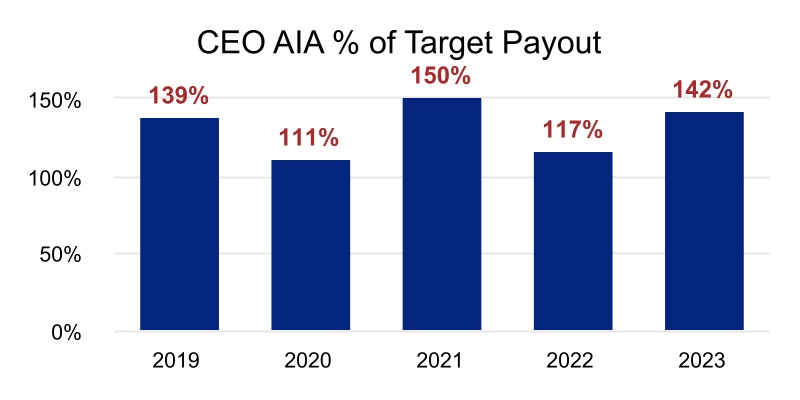
Performance Period 2017 2018 2019 2020 2021 2022 2023 Result % of Target Payout 2017 - 2019 Below Target 53 % 
2018 - 2020 Maximum Earned 200 % 
2019 - 2021 Maximum Earned 200 % 
2020 - 2022 Maximum Earned 200 % 
2021 - 2023 Maximum Earned 200 % 
26 COPT Defense Properties 
WHAT WE DO WHAT WE DON’T DO  Pay for Performance: We tie our NEOs’ compensation to performance by setting clear and challenging objectives with the majority of total target compensation consisting of performance-based components.
Pay for Performance: We tie our NEOs’ compensation to performance by setting clear and challenging objectives with the majority of total target compensation consisting of performance-based components. Multiple Performance Metrics: We use different performance measures for short-and long-term incentives, with multi-year vesting or measurement periods for long-term incentives.
Multiple Performance Metrics: We use different performance measures for short-and long-term incentives, with multi-year vesting or measurement periods for long-term incentives. Risk Oversight: We annually prepare an Enterprise Risk Management assessment. The Compensation Committee carefully considers the risks associated with all elements of our compensation programs.
Risk Oversight: We annually prepare an Enterprise Risk Management assessment. The Compensation Committee carefully considers the risks associated with all elements of our compensation programs. Annual Pay for Performance Analysis: We assess pay and performance relative to peers to ensure that actual payouts align competitively.
Annual Pay for Performance Analysis: We assess pay and performance relative to peers to ensure that actual payouts align competitively. Share Ownership Guidelines: We maintain ownership guidelines for both executives and Trustees. NEO guidelines range from three times to six times base salary, while non-employee Trustee guidelines are five times their annual cash retainer for four quarterly meetings. Executives and Trustees cannot sell company-granted equity until ownership guidelines are met.
Share Ownership Guidelines: We maintain ownership guidelines for both executives and Trustees. NEO guidelines range from three times to six times base salary, while non-employee Trustee guidelines are five times their annual cash retainer for four quarterly meetings. Executives and Trustees cannot sell company-granted equity until ownership guidelines are met. No Guaranteed Bonuses: We do not provide NEOs with guaranteed cash bonuses.
No Guaranteed Bonuses: We do not provide NEOs with guaranteed cash bonuses. No Excise Tax Gross-Ups: We have no agreements in place that provide for reimbursement by the Company for the tax obligations of our employees resulting from severance payments made in the event of a change in control and will not enter into any such agreements in the future.
No Excise Tax Gross-Ups: We have no agreements in place that provide for reimbursement by the Company for the tax obligations of our employees resulting from severance payments made in the event of a change in control and will not enter into any such agreements in the future. No Repricing of Stock Options: We have not issued stock options since 2009. There are currently no outstanding stock options, none of our current NEOs were ever issued stock options and we do not reprice underwater stock options.
No Repricing of Stock Options: We have not issued stock options since 2009. There are currently no outstanding stock options, none of our current NEOs were ever issued stock options and we do not reprice underwater stock options. No Hedging or Pledging: We have an anti-pledging and anti-hedging policy. Subject to the terms of the policy, executives may not (1) hold securities of the Company in a margin account or pledge securities of the Company as collateral for a loan, or (2) enter into hedging or monetization transactions or similar arrangements with respect to securities of the Company.
No Hedging or Pledging: We have an anti-pledging and anti-hedging policy. Subject to the terms of the policy, executives may not (1) hold securities of the Company in a margin account or pledge securities of the Company as collateral for a loan, or (2) enter into hedging or monetization transactions or similar arrangements with respect to securities of the Company. Clawback Policy: We have in place a comprehensive incentive recoupment (i.e., “clawback”) policy.
Clawback Policy: We have in place a comprehensive incentive recoupment (i.e., “clawback”) policy. Use of Independent Compensation Consultant: The Compensation Committee uses an independent consultant that is precluded from performing any work directly for the management of the Company unless pre-approved by the Committee. No such additional work was requested or performed in 2023.
Use of Independent Compensation Consultant: The Compensation Committee uses an independent consultant that is precluded from performing any work directly for the management of the Company unless pre-approved by the Committee. No such additional work was requested or performed in 2023. Peer Group: We use an appropriately sized and defined peer group for compensation benchmarking purposes and review the companies comprising the peer group annually.
Peer Group: We use an appropriately sized and defined peer group for compensation benchmarking purposes and review the companies comprising the peer group annually.
At our May 2023 annual meeting of shareholders, 97.7% of the shareholder say-on-pay proposal votes cast were in favor of the proposal. Our Compensation Committee believes that our shareholders’ substantial approval indicated strong support for our approach to executive compensation. The Committee will continue to consider shareholder feedback and the outcome of our shareholder say-on-pay proposal votes when making future NEO compensation decisions. 
2024 Proxy Statement 27 28 COPT Defense Properties 
> American Assets Trust, Inc. (ticker: AAT) > Highwoods Properties, Inc. (ticker: HIW) > Brandywine Realty Trust (ticker: BDN) > Hudson Pacific Properties, Inc. (ticker: HPP) > Cousins Properties Incorporated (ticker: CUZ) > JBG Smith Properties (ticker: JBGS) > Douglas Emmett, Inc. (ticker: DEI) > Kilroy Realty Corporation (ticker: KRC) > Easterly Government Properties, Inc. (ticker: DEA) > Piedmont Office Realty Trust, Inc. (ticker: PDM) > Elme Communities (ticker: ELME) > STAG Industrial, Inc. (ticker: STAG) > Empire State Realty Trust, Inc. (ticker: ESRT) > Veris Residential, Inc. (ticker: VRE) 
2024 Proxy Statement 29 Base Salary as of December 31, Name of Executive 2022 2023 % Increase Stephen E. Budorick $ 775,000 $ 775,000 0.0 % Britt A. Snider(1) N/A $ 425,000 N/A Anthony Mifsud $ 456,000 $ 456,000 0.0 % Todd Hartman(2) $ 447,000 N/A N/A 30 COPT Defense Properties 

2024 Proxy Statement 31 2023 AIA Opportunity as a % of Base Salary Name of Executive Threshold Level Target Level High Level Stephen E. Budorick 65.0 % 130.0 % 195.0 % Anthony Mifsud 57.5 % 115.0 % 172.5 % Todd Hartman 57.5 % 115.0 % 172.5 % Objective Weighting % Threshold Level Target Level High Level Maximum Level Actual Results(1) Achievement % Weighted Results % Financial Measures FFO per share 30 % $2.34 $2.38 $2.42 $2.46 $2.42 150.0 % 45.0 % Same Properties cash NOI change(2) 10 % 2.0% 3.0% 4.0% 5.0% 4.5% 176.5 % 17.7 % Debt ratio 10 % 6.4x 6.2x 5.9x 5.7x 6.1x 110.0 % 11.0 % Development leasing volume(3) 20 % 325 475 625 775 565 130.0 % 26.0 % New leasing annualized revenue(4) 20 % $9,900 $11,000 $12,100 $13,200 $12,064 148.4 % 29.7 % Core portfolio year end occupancy(5) 10 % 92.8% 93.8% 94.8% 95.8% 94.3% 125.0 % 12.5 % 100 % Final Results 141.8 % Name of Executive Base Salary AIA % of Salary at Target Corporate Objectives Achievement % Actual AIA Award Actual Payout as a % of Salary Stephen E. Budorick $ 775,000 130 % 141.8 % $ 1,428,635 184.3 % Anthony Mifsud $ 456,000 115 % 141.8 % $ 743,599 163.1 % 32 COPT Defense Properties 

2024 Proxy Statement 33 Name of Executive Base Salary Used for Equity Award Total Target Equity Award as a % of Base Salary(1) PB-PIU % of Total Target Equity Target Award Value of PB-PIUs Number of PB-PIUs Awarded(2) Fair Value of PB-PIUs Awarded(3) Stephen E. Budorick $ 775,000 450 % 60 % $ 2,092,488 162,112 $ 2,556,506 Anthony Mifsud $ 456,000 235 % 60 % $ 642,957 49,812 $ 785,535 Todd Hartman(4) $ 456,000 235 % 60 % $ 642,957 49,812 $ 785,535 Percentile Rank Earned PB-PIUs Payout % 75th or greater 100% of PB-PIUs granted 50th (target) 50% of PB-PIUs granted 25th 25% of PB-PIUs granted Below 25th 0% of PB-PIUs granted 34 COPT Defense Properties 
Name of Executive Base Salary Used for Equity Award Total Target Equity Award as a % of Base Salary(1) TB % of Total Target Equity Value of TB-PIUs or RSs Awarded Number of TB-PIUs or RSs Awarded Stephen E. Budorick $ 775,000 450 % 40 % $ 1,395,001 54,238 Anthony Mifsud $ 456,000 235 % 40 % $ 428,650 16,666 Todd Hartman(2) $ 456,000 235 % 40 % $ 428,650 16,666 2007December 2023, received 23,474 TB-PIUs with a grant date fair value of $599,995 on December 1, 2023, as Vice President, Financial Planning & Analysis. Priora new hire equity grant that will vest ratably over a five-year period.joiningalign pay and performance, the following actions will occur, or have already occurred, for 2024:
2024 Proxy Statement 35 Mr. Mifsud servedto receive payments and benefits under the CIC Plan. We believe that the CIC Plan affords our executives with financial security in the event of a change in control, while ensuring that we can retain the appropriate knowledge and expertise needed during a CIC. We also believe that having the CIC Plan encourages the continued dedication of the executives evaluating potential transactions involving the Company that might result in a change in control.Senior Vice President & Treasurerwell as participation in an Executive Wellness Program. As with all other employees of the Company, our executives also receive a monetary award for Municipal Mortgage & Equity, LLC (MMA)achieving service anniversary milestones. The value of these benefits that executives may receive is essentially equivalent to that offered to the broader management and/or employee group and is included in the tables entitled “Summary Compensation Table” and “All Other Compensation.” As demonstrated by the provisions of our CIC Plan, we do not enter into agreements that contain perquisites that may be considered poor pay practices.Role Value of Common Shares to be Owned Trustees 5 times annual retainer and fees for four quarterly meetings CEO 6 times base salary COO 3 times base salary CFO 3 times base salary 36 COPT Defense Properties 
joining MMA, was Vice President, Financial Management at Enterprise Social Investment Corporation. From 1990-2005, Mr. Mifsud held various accountingentering into transactions in our shares or share equivalents. Executives and corporate finance positions at The Rouse Company (formerly NYSE: RSE), culminating as Vice President, Finance from 1999-2005. PriorTrustees are subject to that time, Mr. Mifsud practiced as a CPA and auditor at KPMG Peat Marwick.Share Ownershipblackout periods on the trading of our Trustees,Executive Officersshares for a period of time beginning at each quarter-end and 5% Beneficial Owners
2024 Proxy Statement 37 shows certainsummarizes the compensation earned in 2023, 2022 and 2021 by our NEOs:Name and Principal Position Year Salary Equity-Based Compensation Awards(1) Non-Equity Incentive Plan Compensation(2) Bonus(3) All Other Compensation(4) Total Stephen E. Budorick 2023 $ 775,000 $ 3,951,507 $ 1,428,635 $ — $ 13,200 $ 6,168,342 President + CEO 2022 $ 774,038 $ 3,583,054 $ 1,177,768 $ — $ 12,200 $ 5,547,060 2021 $ 749,712 $ 3,278,200 $ 1,462,500 $ — $ 12,150 $ 5,502,562 Britt A. Snider 2023 $ 17,981 $ 599,995 $ — $ 23,077 $ — $ 641,053 EVP + COO Anthony Mifsud 2023 $ 456,000 $ 1,214,185 $ 743,599 $ — $ 13,200 $ 2,426,984 EVP + CFO 2022 $ 455,615 $ 1,092,238 $ 613,024 $ — $ 13,224 $ 2,174,101 2021 $ 445,946 $ 1,047,816 $ 769,350 $ — $ 11,600 $ 2,274,712 Todd Hartman(5) 2023 $ 94,362 $ 1,214,185 $ — $ — $ 639,507 $ 1,948,054 Former EVP + COO 2022 $ 446,154 $ 995,974 $ 600,924 $ — $ 12,200 $ 2,055,252 2021 $ 425,000 $ 905,614 $ 733,125 $ 115,385 $ 9,836 $ 2,188,960 38 COPT Defense Properties 
Name Year Matching of Contributions to 401(k) Plans Consulting Agreement Payments Other Total Stephen E. Budorick 2023 $ 13,200 $ — $ — $ 13,200 2022 $ 12,200 $ — $ — $ 12,200 2021 $ 11,600 $ — $ 550 $ 12,150 Britt A. Snider 2023 $ — $ — $ — $ — Anthony Mifsud 2023 $ 13,200 $ — $ — $ 13,200 2022 $ 12,200 $ — $ 1,024 $ 13,224 2021 $ 11,600 $ — $ — $ 11,600 Todd Hartman(1) 2023 $ 13,200 $ 584,500 $ 41,807 $ 639,507 2022 $ 12,200 $ — $ — $ 12,200 2021 $ 9,785 $ — $ 51 $ 9,836 Name Type Grant Date Date of Board Action(1) Estimated Possible Payouts Under Non-Equity Incentive Plan Awards ($)(2) Estimated Possible Payouts Under Equity Incentive Plan Awards (#)(3) All Other Stock Awards: Number of Shares of Stock (#)(4) Grant Date Fair Value of Stock Awards ($)(3)(4)(5) Threshold Target High Threshold Target Maximum Stephen E. Budorick AIA 11/9/2022 503,750 1,007,500 1,511,250 PB-PIU 1/1/2023 11/9/2022 40,528 81,056 162,112 2,556,506 TB-PIU 3/1/2023 11/9/2022 54,238 1,395,001 Britt A. Snider TB-PIU 12/1/2023 23,474 599,995 Anthony Mifsud AIA 11/9/2022 262,200 524,400 786,600 PB-PIU 1/1/2023 11/9/2022 12,453 24,906 49,812 785,535 TB-PIU 3/1/2023 11/9/2022 16,666 428,650 Todd Hartman AIA 11/9/2022 262,200 524,400 786,600 PB-PIU 1/1/2023 11/9/2022 12,453 24,906 49,812 785,535 TB-PIU 3/1/2023 11/9/2022 16,666 428,650 March 2, 2018 (unless otherwise noted) regardingthat date. Mr. Snider’s new hire TB-PIU award was granted on December 1, 2023.beneficial ownershipsection entitled “Compensation Discussion and Analysis,” the Board approved AIAs for the NEOs, as a percentage of base salary, for three levels of aggregate performance. These columns show the estimated future payouts of AIAs for the three aggregate levels of performance approved by the Board for 2023, as converted from the percentages of 2023 base salary.
2024 Proxy Statement 39 Stock Awards Name Grant Date Number of Time-Based Equity Awards That Have Not Vested(1) Market Value of Time-Based Awards That Have Not Vested ($)(2) Equity Incentive Plan Awards: Number of Unearned Units(3) Equity Incentive Plan Awards: Market or Payout Value of Unearned Units ($)(4) Stephen E. Budorick 3/1/2021 15,386 394,343 — — 1/1/2022 — — 74,753 1,915,919 3/1/2022 32,280 827,336 — — 1/1/2023 — — 83,940 2,151,382 3/1/2023 54,238 1,390,120 — — Britt A. Snider 12/1/2023 23,474 601,639 — — Anthony Mifsud 3/1/2021 4,918 126,048 — — 1/1/2022 — — 22,787 584,031 3/1/2022 9,840 252,199 — — 1/1/2023 — — 25,792 661,049 3/1/2023 16,666 427,150 — — 40 COPT Defense Properties 
Name Number of Shares Acquired on Vesting(1) Value Realized on Vesting(2) Stephen E. Budorick 199,761 $ 5,110,899 Anthony Mifsud 63,849 $ 1,633,581 Todd Hartman 8,736 $ 222,156 Value of Initial Fixed $100 Investment Based on(4) Year Summary Compensation
Table Total for CEO(1)Compensation Actually Paid to CEO(2) Average Summary Compensation Table Total for Non-CEO NEOs(3) Compensation Actually Paid to Non-CEO NEOs(2) COPT Defense Total Shareholder Return Office Property Sector of FTSE Nareit All Equity REITs Index Total Shareholder Return(5) Net Income(6) FFO per Share(7) 2023 $ 6,168,342 $ 7,178,869 $ 1,672,030 $ 559,464 $ 103.90 $ 63.34 $ (74,347) $ 2.42 2022 $ 5,547,060 $ 8,518,704 $ 2,114,677 $ 2,814,964 $ 100.32 $ 62.07 $ 178,822 $ 2.36 2021 $ 5,502,562 $ 7,170,639 $ 2,231,836 $ 2,539,830 $ 103.69 $ 99.51 $ 81,578 $ 2.29 2020 $ 4,548,812 $ 4,844,929 $ 1,405,232 $ 550,795 $ 92.89 $ 81.56 $ 102,878 $ 2.12 
2024 Proxy Statement 41 CEO Non-CEO NEOs 2023 2022 2021 2020 2023 2022 2021 2020 $ 6,168,342 $ 5,547,060 $ 5,502,562 $ 4,548,812 $ 1,672,030 $ 2,114,677 $ 2,231,836 $ 1,405,232 Subtract: Grant Date Fair Value of Awards in Year(1) (3,951,507) (3,583,054) (3,278,200) (2,741,199) (1,009,455) (1,044,106) (976,715) (822,167) Add: Year End Fair Value of Outstanding and Unvested Awards Granted in Year(2) 3,997,691 4,228,174 3,454,244 2,552,887 610,005 1,232,094 1,029,165 489,327 Add/Subtract: Change in Fair Value of Outstanding and Unvested Prior Year Grants(3) 20,856 1,066,829 338,161 (73,623) 2,096 307,193 74,414 (7,703) Add/Subtract: Change in Fair Value of Vested Prior Year Grants(4) 627,112 892,804 892,746 533,320 65,331 146,828 140,535 33,458 Subtract: Prior Year End Value of Grants Forfeited in Year(5) — — — — (816,120) — — (550,372) Add: Dividends and Distributions on Stock Awards Not Included in Award Fair Value(6) 316,375 366,891 261,126 24,732 35,577 58,278 40,595 3,020 $ 7,178,869 $ 8,518,704 $ 7,170,639 $ 4,844,929 $ 559,464 $ 2,814,964 $ 2,539,830 $ 550,795 Trustee,stock award that was granted in a prior fiscal year and remained outstanding and unvested as of the last day of the indicated fiscal year.nomineestock award that was granted in a prior fiscal year, and vested during the indicated fiscal year.electiondividends or distributions on earned awards.42 COPT Defense Properties 
Trustee,well as the relationship of our TSR to that of the peer group (the Office Property Sector of the FTSE Nareit All Equity REITs index):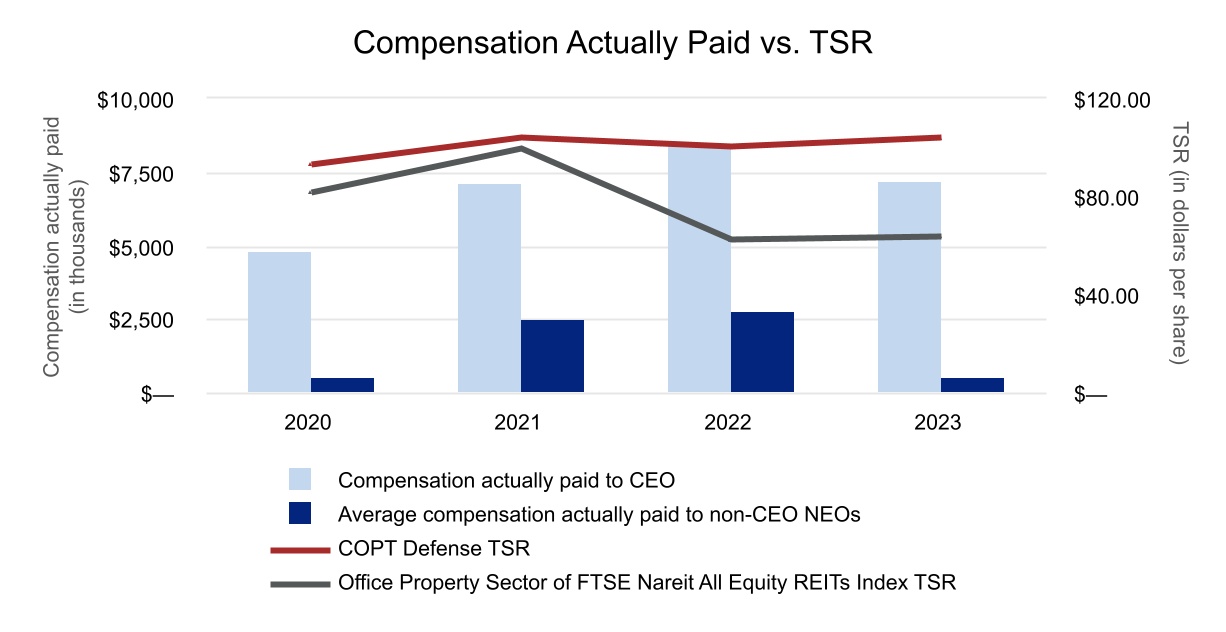
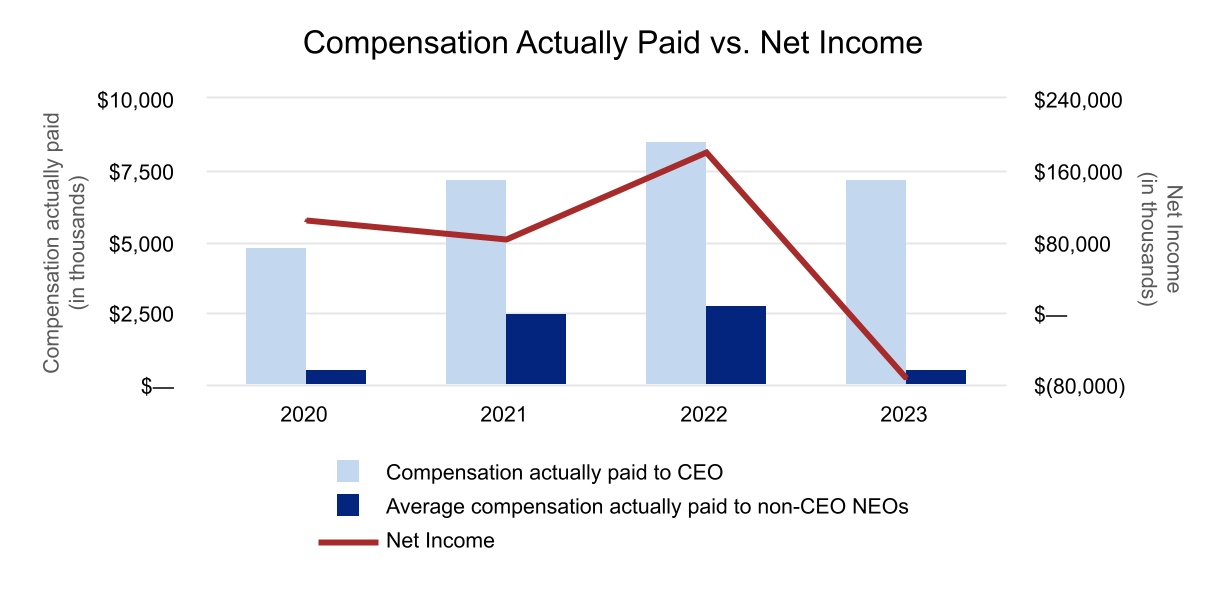

2024 Proxy Statement 43 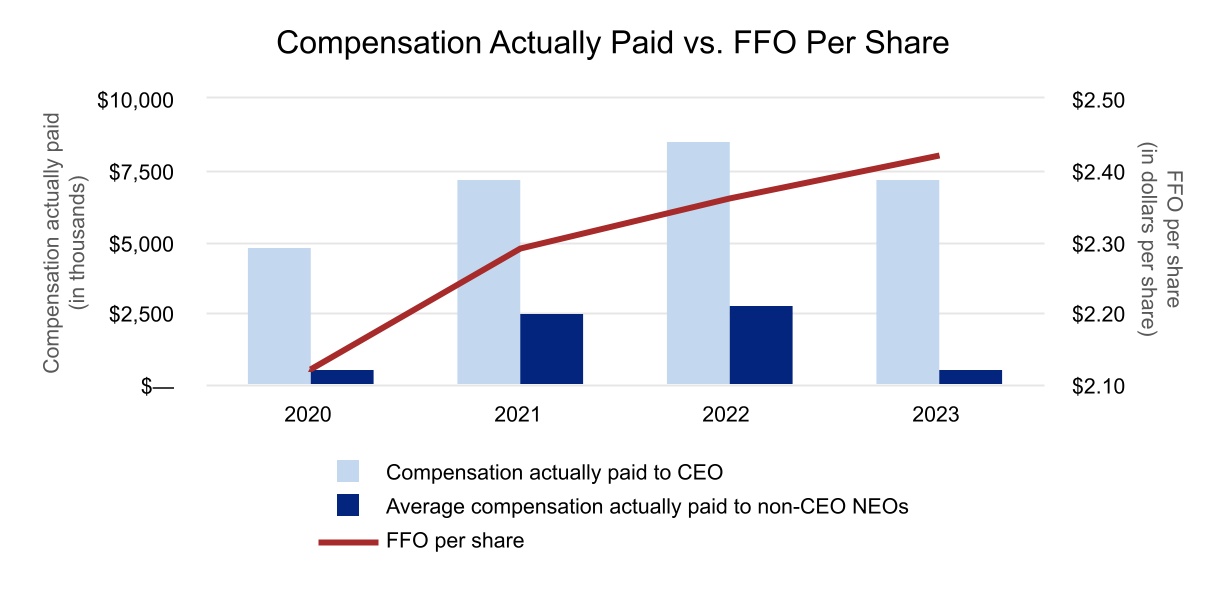
44 COPT Defense Properties 
Name Cash Severance Payments Continuation of Medical/Welfare Benefits(1) Value of Time-Based Vestings(2) Value of Performance-Based Vestings(3) Total Termination Benefits Stephen E. Budorick Premature/Constructive Termination $ 5,013,872 $ 25,330 $ 2,611,800 $ 1,996,059 $ 9,647,061 Constructive Termination in Connection with Change in Control $ 6,997,026 $ 25,330 $ 2,611,800 $ 1,996,059 $ 11,630,215 Change in Control $ — $ — $ — $ 1,996,059 $ 1,996,059 Death or Disability $ — $ — $ — $ 1,996,059 $ 1,996,059 Britt A. Snider Premature/Constructive Termination $ 913,750 $ 12,665 $ 601,639 $ — $ 1,528,054 Constructive Termination in Connection with Change in Control $ 2,732,113 $ 12,665 $ 601,639 $ — $ 3,346,417 Change in Control $ — $ — $ — $ — $ — Death or Disability $ — $ — $ — $ — $ — Anthony Mifsud Premature/Constructive Termination $ 1,633,097 $ 11,065 $ 805,397 $ 610,211 $ 3,059,770 Constructive Termination in Connection with Change in Control $ 3,839,405 $ 11,065 $ 805,397 $ 610,211 $ 5,266,078 Change in Control $ — $ — $ — $ 610,211 $ 610,211 Death or Disability $ — $ — $ — $ 610,211 $ 610,211 
2024 Proxy Statement 45 
recommends
a vote FOR
this proposal.As of March 8, 2024 RSs 360,103 Unvested PB-PIUs(1) 743,454 Unvested TB-PIUs 229,133 Deferred share awards, vested and unvested(2) 79,269 Dilution associated with outstanding awards (A) 1,411,959 Outstanding common shares and units, including RSs and vested PIUs 114,562,180 Overhang 1.2 % Shares available under 2017 Plan 396,445 Additional shares assuming approval of the Amendment 3,500,000 Shares available under 2017 Plan including additional shares under Amendment (B) 3,896,445 Dilution associated with awards outstanding or available under 2017 Plan and additional shares under Amendment (A+B) 5,308,404 Outstanding common shares and units, including RSs and vested PIUs 114,562,180 Overhang assuming approval of the Amendment 4.6 % 46 COPT Defense Properties 
executive officer,NEO are performance-based equity subject to vesting based on relative TSR over a three-year period.
2024 Proxy Statement 47 2023 2022 2021 Share options granted (A) — — — Time-based full-value awards granted(1) 353,282 295,252 275,394 Performance-based full-value awards settled(2) 141,152 156,104 93,824 Total full-value awards (B) 494,434 451,356 369,218 Weighted average common shares/units outstanding during the fiscal year (C)(3) 113,840,000 113,527,000 113,217,000 0.43 % 0.40 % 0.33 % 0.39 % ISS industry category burn rate threshold 1.05 % Trusteesof its operations through an operating partnership, both common shares of the Company and executivecommon units of the Company's Operating Partnership not owned by the Company are included for purposes of calculating our burn rate. Each common unit of the Company's Operating Partnership is exchangeable into common shares on a one-for-one basis, subject to certain conditions.48 COPT Defense Properties 
groupresult of a proportionate adjustment made in connection with a reorganization, recapitalization, reclassification, share dividend, share split, reverse share split, extraordinary dividend or other similar event.
2024 Proxy Statement 49 person knownoption will be determined by the Administrator but may not be less than 100% of the fair market value of our common shares on the date of grant.usthe Company or its designee.beneficial ownernumber of shares issued to the optionee by the number of shares with a fair market value equal to the exercise price.5%ten years after the date the share appreciation right is granted.50 COPT Defense Properties 
shares. Beneficial ownership is determined in accordanceshareholders. The Board may determine to make amendments subject to the approval of the common
2024 Proxy Statement 51 SecuritiesNYSE or to preserve the qualified status of incentive options or ensure that compensation earned under the 2017 Plan qualifies as performance-based compensation under Section 162(m) of the Internal Revenue Code of 1986 (the "Code"). Otherwise, our Board may amend or discontinue the 2017 Plan at any time.Exchange Commissionafter one year from the date of exercise, then (1) upon sale of such shares, any amount realized in excess of the option price (the amount paid for the shares) will be taxed to the optionee as a long-term capital gain, and means soleany loss sustained will be a long-term capital loss, and (2) we will not be entitled to any deduction for federal income tax purposes. The exercise of an incentive option will give rise to an item of tax preference that may result in alternative minimum tax liability for the optionee.shared votinga portion of the exercise price of the incentive option is paid by tendering shares.dispositive powerdepreciation after the date of exercise is treated as either short-term or long-term capital gain or loss depending on how long the shares have been held. Special rules will apply where all or a portion of the exercise price of the non-qualified option is paid by tendering shares. Upon exercise, the optionee will also be subject to Social Security taxes on the excess of the fair market value over the exercise price of the option.securities. Each party namedsuch accelerated awards to be treated as "parachute payments," as defined in the Code. Any such parachute payments may be non-deductible to us, in whole or in part, and may subject the recipient to a non-deductible 20% federal excise tax on all or a portion of such payment (in addition to other taxes ordinarily payable).52 COPT Defense Properties 
Plan Category Number of Securities to be Issued Upon Exercise of Outstanding Options, Warrants and Rights (a) Weighted-average Exercise Price of Outstanding Options, Warrants and Rights (b) Number of Securities Remaining Available for Future Issuance Under Equity Compensation Plans (Excluding Securities in Column (a)) (c) Equity compensation plans approved by security holders 1,463,349 (1) N/A (2) 934,764 (3) Equity compensation plans not approved by security holders — N/A — Total 1,463,349 N/A 934,764 
2024 Proxy Statement 53 
recommends
a vote FOR
this proposal.The Audit Committee has selected and appointed PwC as our independent registered public accounting firm to audit our consolidated financial statements for the year ending December 31, 2023. sole votingbeen our auditor since 1997 and dispositive powerthe Audit Committee considered the factors discussed below in determining to reappoint PwC. Even if the appointment is ratified, the Audit Committee, in its discretion, may select a different Independent Auditor at any time if the Audit Committee believes that such a change would be in the best interests of the Company and its shareholders. If our shareholders do not ratify the appointment of PwC, the Audit Committee will take that fact into consideration, together with such other factors it deems relevant, in determining its next selection of Independent Auditor.2023 2022 Audit fees(1) $ 2,094,459 $ 1,905,653 Audit-related fees(2) 76,407 72,769 Tax fees(3) 346,150 331,600 All other fees(4) — 41,000 Total $ 2,517,016 $ 2,351,022 54 COPT Defense Properties 
securities listed opposite such party's name, except as otherwise noted. Common Shares
Beneficially
Owned(1) Percent of All
Common
Shares
Beneficially
Owned(2) Awards
Available
within 60 days
after March 2,
2018(3) 16,364,259 16.1% — 11,314,176 11.1% — 8,960,593 8.8% — 5,937,058 5.9% — 29,612 * 19,222 293,508 * 5,000 10,258 * 9,222 20,787 * 3,007 13,633 * 5,000 37,700 * 10,000 26,020 * 9,222 24,612 * 5,000 7,464 * — 102,997 * — 56,002 * — 38,126 * — 660,719 0.6% 65,673 *Represents less than one percent.(1)With respect to each shareholder (or group thereof), assumes that all units in our operating partnership, Corporate Office Properties, L.P. (the "Operating Partnership"), owned by such shareholder(s) listed are exchanged for common shares and assumes we elect to issue common shares rather than pay cash upon exchange of partnership units. Also includes shares issuable under awards held by such shareholder(s) available within 60 days after March 2, 2018, as reflected in the third column of this table.(2)Common shares issuable upon the conversion of units in the Operating Partnership and the exercise of options exercisable currently or within 60 days after March 2, 2018 are deemed outstanding and to be beneficially owned by the person holding such units or options for purposes of computing such person's percentage ownership, but are not deemed outstanding for the purpose of computing the percentage ownership of any other person.(3)Includes common shares issuable under options held by such shareholder(s) exercisable within 60 days after March 2, 2018 and vested restricted share units held by such shareholder(s).(4)The Vanguard Group ("Vanguard") has sole voting power with respect to 167,879 shares, shared voting power with respect to 130,990 shares, sole investment power with respect to 16,187,481 shares and shared investment power with respect to 176,778 shares. Of these shares, the Vanguard REIT Index Fund (the "Index Fund") has sole voting power over 6,697,481 shares. Vanguard and the Index Fund are located at 100 Vanguard Blvd., Malvern, Pennsylvania 19355. The information in this note was derived from a Schedule 13G/A filed with the Securities and Exchange Commission by the Index Fund on February 2, 2018 and a Schedule 13G/A filed with the Securities and Exchange Commission by Vanguard on February 9, 2018.(5)BlackRock, Inc. ("BlackRock") has sole voting power with respect to 10,883,779 shares and sole investment power with respect to 11,314,176 shares. BlackRock is located at 55 East 52nd Street, New York, New York 10055. The information in this note was derived from a Schedule 13G/A filed with the Securities and Exchange Commission by BlackRock on January 19, 2018.(6)Wellington Management Group LLP ("Wellington") has shared voting power with respect to 7,532,902 shares and shared investment power with respect to 8,960,593 shares. Wellington is located at 280 Congress Street, Boston, Massachusetts 02210. The information in this note was derived from a Schedule 13G filed with the Securities and Exchange Commission by Wellington on February 8, 2018.(7)FMR LLC ("FMR") has sole voting power with respect to 501,798 shares and sole investment power with respect to 5,937,058 shares. FMR is located at 245 Summer Street, Boston, Massachusetts 02210. The information in this note was derived from a Schedule 13G filed with the Securities and Exchange Commission by FMR on February 13, 2018.(8)Includes 286,000 common units in the Operating Partnership exchangeable for common shares, 90,000 (30.7% of Mr. Denton's total common unit and common share holdings) of which were pledged as security for a line of credit. In 2014, the Company adopted an anti-pledging policy and grandfathered this pre-existing pledge. The pledged shares are excluded from the computation of Mr. Denton's shares as required by our share ownership guidelines.(9)Includes 5,000 shares held through the C. Taylor Pickett Family Trust. Mr. Pickett does not have voting or investment power with respect to these shares.Section 16(a) Beneficial Ownership Reporting Compliance The rulesNone of the Securities and Exchange Commission require that we disclose late filings of initial reports of share ownership and reports of changes in share ownershipfees reflected above were approved by our Trustees, officers and greater than 10% shareholders. Our Trustees, officers and greater than 10% shareholders are required by those rules to furnish us with copies of the reports of share ownership (and changes in share ownership) they file with the Securities and Exchange Commission. Based solely on our review of the copies of such reports received by us and other information provided by these parties, we believe that during the year ended December 31, 2017, our Trustees, officers and greater than 10% shareholders filed all required reports on a timely basis, except that a Form 4 relating to the conversion of limited partnership units on February 10, 2017 by Mr. Denton and a Form 4 relating to the exercise of options on May 2, 2017 by Mr. Denton were each filed five days late.Code of Ethics; Review and Approval of Related Party Transactions The Company has a Code of Business Conduct and Ethics for all employees and Trustees and a Code of Ethics for Financial Officers. These codes of ethics documents are available in the investor relations section of the Company's Internet website in the subsection entitled "Corporate Governance." The Company's Internet website address is www.copt.com. We will make available on our Internet website any future amendments or waivers to our Code of Business Conduct and Ethics and Code ofEthics for Financial Officers within four business days after any such amendments are adopted or waivers are granted. In addition, shareholders may request a copy of these codes of ethics documents, free of charge, by making this request in writing to our Vice President, Investor Relations at ir@copt.com or at our mailing address. Our Code of Business Conduct and Ethics mandates that the Audit Committee must review and approve any "related party transaction," as defined by relevant SEC rules (generally, transactions involving amounts exceeding $120,000 in which a related person has a direct or indirect material interest). In considering the transaction, the Audit Committee will consider all relevant factors, including, among others, our business rationale for entering into the transaction, any potential alternatives to entering into the transaction, whether the transaction is on terms that would be comparable to those available to third parties and the overall fairness of the transactionpursuant to the Company. In general, either management or the affected Trustee or executive officer will bring the matter to the attention“de-minimis exception” in Rule 2-01 of either the chairmanRegulation S-X.the Audit Committee or our Vice President, Secretary and General Counsel. If a member of the Audit Committee is involved in the transaction, he/shePwC will be recused from all discussionspresent at the 2024 Annual Meeting. The representative will have an opportunity to make a statement if he or she desires to do so and decisions about the transaction. The transaction must be approved in advance whenever practicable, and if not practicable, must be ratified as promptly as practicable.Securities and Exchange Commission'sSEC’s additional independence requirements for members of audit committees. The Board has determined that Robert L. Denton, Sr., Steven D. Kesler, David M. Jacobstein and Lisa G. Trimberger are each qualify as an "audit“audit committee financial expert"expert” as defined by the Securities and Exchange Commission.SEC. The Audit Committee adopted, and the Board approved, a charter outlining the Audit Committee'sCommittee’s practices. A copy of the charter is publicly available in the investor relationsInvestors section of the Company'sour Internet website in the subsection entitled "Corporate Governance."“Governance.” The Audit Committee'sCommittee’s charter is also available in print to any shareholder upon request. To the extent modifications are made to the Audit Committee'sCommittee’s charter, such modifications will be reflected in the copy of the charter maintained on the Company'sour Internet website.the Company'sour financial statements, financial reporting process, internal control over financial reporting, compliance with legal and regulatory requirements and ethical behavior. Our Independent Auditor is responsible for expressing opinions on the conformity of the Company'sour consolidated financial statements with generally accepted accounting principles, the fairness of the presentation of the Company'sour financial statement schedules and the effectiveness of the Company'sour internal control over financial reporting in accordance with the Public Company Accounting Oversight Board ("PCAOB"(“PCAOB”). The Company'sOur internal audit function is responsible for, among other things, helping to evaluate and improve the effectiveness of risk management, control and governance processes and identifying opportunities to assist in improving the Company'sour operations. Our information technology team, led by our Vice President-Information Technology and Chief Information Officer, is responsible for our cybersecurity risk management efforts, including our assessment, identification and management of such risks. The role of the Audit Committee is to oversee these activities.the Company'sour system of internal control over financial reporting pursuant to the requirements set forth in Section 404 of the Sarbanes-Oxley Act of 2002 and related regulations. The Audit Committee was kept apprised of the progress of the evaluation and provided oversight during the process. In connection with this oversight, the Committee received periodic updates provided by management and the internal audit function at each regularly scheduled Committee meeting. At the conclusion of the process, management concluded that the Company'sour internal control over financial reporting was effective as of December 31, 20172023, and reported its conclusion to the Audit Committee. The Committee reviewed Management'sManagement’s Report on Internal Control over Financial Reporting contained in the Company's and the Operating Partnership'sCompany’s Annual20172023, filed with the Securities and Exchange Commission,SEC, as well as the Independent Auditor'sAuditor’s Report of Independent Registered Public Accounting Firm included in the Company's and the Operating Partnership'sCompany’s Annual Report on Form 10-K. The Report of Independent Registered Public Accounting Firm relatedpertained to the audit of: (1) the consolidated financial statements and financial statement schedule included in the Annual Report on Form 10-K; and (2) the effectiveness of internal control over financial reporting. The Committee continues to oversee the Company'sour efforts related to itsour internal control over financial reporting and management'smanagement’s preparations for the evaluation in 2018.the Company'sour accounting and financial management team, the internal audit function and the Independent Auditor to review the Company'sour annual and quarterly periodic filings containing consolidated financial statements prior to the Company'sour submission of such filings to the Securities and Exchange Commission.SEC. In addition, the Audit Committee met separately each with the internal audit
2024 Proxy Statement 55 Company's and the Operating Partnership'sCompany’s consolidated financial statements for the year ended December 31, 20172023, were prepared in accordance with generally accepted accounting principles. The Audit Committee discussed with the Independent Auditor the matters required to be discussed under Statement on Auditing Standards No. 16, as amended, which addresses communication between audit committees and independent registered public accounting firms. The Audit Committee received from the Independent Auditor the written disclosures and letter required by PCAOB Rule 3526, which addresses independence discussions between auditors and audit committees. The Audit Committee also held discussions with the Independent Auditor regarding its independence from the Company and its management and considered whether the Independent Auditor'sAuditor’s provision of audit and non-audit services provided to the Company during 20172023 was compatible with maintaining the firm'sfirm’s independence.Auditor'sAuditor’s independence. All services were approved by the Audit Committee prior to the services being rendered.("PwC"(“PwC”) as the Company'sour Independent Auditor, the Audit Committee took into account a number of factors, including: the length of time that PwC has been engaged; PwC'sPwC’s independence and objectivity; PwC'sPwC’s capability and expertise in handling the Company'sour industry, including the expertise and capability of the lead auditengagement partner; historic and recent performance, including the extent and quality of PwC'sPwC’s communications with the Audit Committee, andCommittee; the results of a management surveyand Audit Committee surveys of PwC'sPwC’s overall performance; data related to audit quality and performance, including recent PCAOB inspection reports on the firm; and the appropriateness of PwC'sPwC’s fees, both on an absolute basis and as compared with its peers. In reliance on the reviews and discussions referred to above, the Audit Committee recommended to the Board that the Company'speers; and the Operating Partnership's audited consolidated financial statements for the year ended December 31, 2017 be included in the Company's and the Operating Partnership's Annual Report on Form 10-K for the year ended December 31, 2017 for filing with theSecurities and Exchange Commission. time that PwC has been engaged.AUDIT COMMITTEE AUDIT COMMITTEEDavid M. Jacobstein,Lisa G. Trimberger, Chair
Robert L. Denton, Sr.
Steven D. KeslerRichard SzafranskiLisa G. Trimberger
Letitia A. Long
Essye B. MillerSecurities Exchange Act of 1934, as amended, except to the extent that the Company specifically incorporates this information by reference, and shall not otherwise be deemed filed under such acts.Independent Registered Public Accounting Firm PwC served asIndependent AuditorInternet website in the subsection entitled “Governance” at https://investors.copt.com/corporate-governance/governance-documents. We will make available on our Internet website any future amendments or waivers to our Code of Business Conduct and Ethics and Code of Ethics for the years ended December 31, 2017 and 2016. PwC also provided us with other auditing and advisory services. WeFinancial Officers within four business days after any such amendments are cognizantadopted or waivers are granted. In addition, shareholders may request a copy of the need for PwC to maintain its independence and objectivity in order to effectively serve in its role as our Independent Auditor. As a result, our Audit Committee restricted the services for which PwC can be engaged to those services that could not impair or appear to impair PwC's independence and objectivity. Inthese codes of ethics documents, free of charge, by making this determination,request in writing to our Vice President, Investor Relations at ir@copt.com or at our mailing address.56 COPT Defense Properties 
contemplatesmust review and approve any “related party transaction,” as defined by relevant SEC rules (generally, transactions involving amounts exceeding $120,000 in which a related person has a direct or indirect material interest). In considering the nature of the services, the benefits that PwC performing such services brings both to the services and to their audit and PwC's proposed cost for providing such services. The Audit Committee has procedures in place regarding the pre-approval of all services provided by PwC. Specifically, management contactstransaction, the Audit Committee Chair regardingwill consider all relevant factors, including, among others, our business rationale for entering into the transaction, any potential need for a service from PwC. PwC then provides an engagement letteralternatives to management pertainingentering into the transaction, whether the transaction is on terms that would be comparable to those available to third parties and the overall fairness of the transaction to the service, whichCompany. During 2023, there were no related-party transactions involving our Trustees or NEOs.reviews foror the service description and proposed fee. Once management agrees withaffected Trustee or executive officer will bring the engagement letter, it forwardsmatter to the engagement letter toattention of either the chairman of the Audit Committee Chair. The Audit Committee Chair then reviews the engagement letter for the criteria described in the previous paragraphor our Vice President, Secretary and if, based on such review, he approvesGeneral Counsel. If a member of the terms of the engagement letter, he forwards the letter to the other Audit Committee members requesting that they respond within a certain period of time should they not approve of the engagement letter. The Audit Committee has delegated pre-approval authority to the Chair for certain audit-related services. All fees paid to PwC in 2017 were approved by the Audit Committee is involved in the transaction, he/she will be recused from all discussions and decisions about the transaction. The transaction must be approved in advance whenever practicable, and if not practicable, must be ratified as promptly as practicable.this policy. For the years ended December 31, 2017rules of the SEC and 2016, we incurredmeans sole or shared voting or investment power with respect to securities. Each party named in the approximate feestable below has sole voting and expenses set forth belowinvestment power with PwC: 2017 2016 $ 1,638,217 $ 1,519,987 56,455 54,679 215,870 244,510 $ 1,910,542 $ 1,819,176 Common Shares Beneficially Owned(1) Percent of All Common Shares Beneficially Owned(2) Awards Available within 60 days after March 8, 2024(3) BlackRock, Inc.(4) 17,908,018 15.90 % — The Vanguard Group(5) 16,664,736 14.79 % — State Street Corporation(6) 6,893,387 6.12 % — Trustees and executive officers Thomas F. Brady 40,353 * 26,866 Robert L. Denton, Sr.(7) 186,287 * — Philip L. Hawkins(8) 35,499 * 15,188 Steven D. Kesler 41,313 * — Letitia A. Long(9) 10,064 * 2,707 Essye B. Miller 2,830 * 2,830 Raymond L. Owens(10) 8,263 * — C. Taylor Pickett(11) 86,761 * 15,188 Lisa G. Trimberger(12) 19,863 * 7,444 Stephen E. Budorick(13) 582,986 * — Britt Snider 1,000 * — Anthony Mifsud(14) 185,698 * — Todd Hartman(15) 17,806 * — 1,200,917 1.06 % 70,223 Audit fees include fees billed for services renderedconnectionaccordance with audits of (i) the Company's andSEC rules. With respect to each shareholder (or group thereof), assumes that all common units in the Operating Partnership's consolidated financial statementsPartnership owned by such shareholder(s) listed, including common units associated with exchangeable profit interest units, are exchanged for common shares and financial schedules includedassumes we elect to issue common shares rather than pay cash upon exchange of common units. Also includes
2024 Proxy Statement 57 Annual Report on Form 10-K; and (ii)third column of this table.effectiveness of the Company's andcommon units in the Operating Partnership's internal control over financial reporting. These fees totaled $1,513,917 in 2017 and $1,407,187 in 2016. Audit fees also include issuances of comfort letters on filingsPartnership currently or within 60 days after March 8, 2024, including common units associated with public offeringsexchangeable profit interest units, are deemed outstanding and consentsto be beneficially owned by the person holding such units for purposes of computing such person’s percentage ownership, but are not deemed outstanding for the purpose of computing the percentage ownership of any other person.registration statements.(2)Audit-related fees consist of fees billedJanuary 22, 2024.assurancecommon shares.related services that are reasonably related20,000 shares held in the Laura Stees Pickett Trust. Mr. Pickett does not have voting or investment power with respect to the performanceshares held in the trusts.
for the audit or reviewAnnual Meeting of Shareholders to be Held Virtually on May 9, 2024consolidated financial statements but not includedNEOs as disclosed in (1) above. This category includes feesthis proxy statement.the auditissuance thereunder by 3,500,000 shares. financial statements of our employee retirement savings plan.(3)Tax fees consist of fees billed for professional services rendered for tax compliance, tax advice, tax planning and services in connection with technology used for tax compliance in 2017 and 2016.None of the fees reflected above were approved by the Audit Committee pursuant to the "de-minimis exception" in Rule 2-01 of Regulation S-X. We expect that a representative of PwC will be present at the 2018 Annual Meeting. The representative will have an opportunity to make a statement if he or she desires to do so and to answer appropriate questions.Proposal 2—Ratification of the Appointment of Independent Auditor The Audit Committee has selected and appointed PwC as our Independent Auditor to audit our consolidated financial statements for the year ending December 31, 2018. Although ratification by shareholders is not required by law or by our Bylaws, the Audit Committee believes that submission of its selection to shareholders is a matter of good corporate governance. PwC has been the Company's auditor since 1997 and the Operating Partnership's auditor since 2013 and the Audit Committee considered the factors mentioned above in determining to reappoint PwC. Even if the appointment is ratified, the Audit Committee, in its discretion, may select a different Independent Auditor at any time if the Audit Committee believes that such a change would be in the best interests of the Company and its shareholders. If our shareholders do not ratify the appointment of PwC as our independent registered public accounting firm for the Audit Committee will takecurrent fiscal year.58 COPT Defense Properties 
fact into consideration, together with such other factors it deems relevant, in determining its next selection of Independent Auditor. Representatives of PwC will be presentproperly comes before the Annual Meeting for a vote.haveconduct this year’s Annual Meeting virtually through a live online webcast. We will not conduct this year’s Annual Meeting in person. As in prior years, to participate in the Annual Meeting and to vote your shares, you must either be present on the webcast or represented by proxy at the Annual Meeting. Since many of our shareholders may be unable to virtually attend the Annual Meeting, we send our shareholders the Notice Regarding the Availability of Proxy Materials to enable them to vote.opportunityintermediary (i.e., a bank, broker or other nominee) and you wish to makeparticipate in the live internet webcast of the Annual Meeting and/or vote at the meeting, please follow the instructions below:statement if such representative so desirestimely fashion, you contact your bank, broker or other nominee well in advance of the Annual Meeting.havebe voted by the identified proxies.




2024 Proxy Statement 59 opportunity to respond to appropriate questions by shareholders.The Board recommends a vote "FOR"advisory basis, of the compensation of our NEOs as disclosed in this proxy statement;PricewaterhouseCoopers LLPPwC as our Independent Auditor for the current fiscal year.Amendmentanyone else who intends to do so. However, your proxies are authorized to vote on your behalf, in their discretion, on any other business that properly comes before the AmendedAnnual Meeting.Restated DeclarationSecretary, David L. Finch, in writing at our mailing address set forth on the first page of Trust Granting Shareholdersthis proxy statement, that you are revoking your proxy;Right to ApproveInternet or by QR Code or telephone, by providing new instructions by the same means; orMerger or Business Combination by Simple Majority Vote The Boardquorum?Trustees adopted, and now recommends for shareholder approval, a proposal to amend Article XIMarch 8, 2024, COPT Defense Properties had 112,640,861 common shares outstanding. A majority of the Amendedoutstanding shares present or represented by proxy constitutes a quorum. If you complete the voting process by Internet or telephone or sign and Restated Declarationreturn your proxy card, your shares will be counted in determining the presence of Trust to grant shareholdersa quorum, even if you abstain or otherwise withhold your vote. If a quorum is not present at the right to approve a merger or other business combination by simple majority vote of all the votes entitled to be cast on the matter (the "Declaration Amendment"). Article XI of the Amended and Restated Declaration of Trust currently provides that a merger or other business combination may be approved by the affirmative vote of two-thirds of all the votes entitled to be cast on the matter. If the Declaration Amendment is approved byAnnual Meeting, the shareholders present in person or by proxy may adjourn the shareholders will have the rightmeeting to approve mergers, consolidations or sale of all, or substantially all, of the Company's assets bya date not more than 120 days after March 8, 2024, until a quorum is present.allthe total votes cast for and against such nominee. The majority voting standard would not apply in contested elections.60 COPT Defense Properties 
entitledcast at a meeting of shareholders is required to approve any other matter unless a greater vote is required by law or by our Declaration of Trust. With respect to the other Proposals to be castvoted on the matter. The text of the proposed Declaration Amendment is attached asAnnex A to this proxy statement. Vote Required. If a quorum is present at the Annual Meeting, the required vote to approve each of Proposal 2, 3 and 4 is a vote of two-thirds of allmajority of the commonvotes cast on each such proposal. See "How Will My Vote Be Counted" for more detail on the treatment of abstentions and "broker non-votes" on Proposals 2, 3 and 4.outstandingfor a beneficial owner returns a signed proxy but does not vote on a particular proposal because the nominee does not have discretionary voting power with respect to that item and entitledhas not received instructions from the beneficial owner.at the Annual Meeting will be requiredfor or against each nominee. You may also abstain with respect to approve the proposal to amend the Amended and Restated Declaration of Trust to grant shareholders the right to approve mergers or other business combinations by majority vote. Abstentionseach nominee. Because abstentions and broker non-votes are not considered votes cast, they will have no effect on the outcome of the vote on election of Trustees.
2024 Proxy Statement 61 62 COPT Defense Properties 
recommends a vote "FOR" approval of the Amendment to the Amended and Restated Declaration of Trust to grant shareholders the right to approve a merger or business combination by simple majority vote.Proposal 4—Advisory Vote to Approve Executive Compensation The Dodd-Frank Wall Street Reform and Consumer Protection Act of 2010, or the Dodd-Frank Act, enables our shareholders to vote to approve, on an advisory basis, the compensation of our named executive officers as disclosed in this proxy statement in accordance with the Securities and Exchange Commission's rules. This is commonlyCOPT Defense Properties (formerly known as and is referredCorporate Office Properties Trust, the “Company”) duly adopted a resolution approving the Second Amendment as set forth above subject to herein as, a "say-on-pay" proposal or resolution. Our compensation programs are designed to clearly link annual and long-term financial results and shareholder return to executive rewards. The majority of each executive's total compensation is tied directly to goal achievement; this pay for performance approach ensures that the financial interests of our executives are aligned with those of our shareholders. Please refer to the section entitled "Compensation Discussion and Analysis" for additional details about our executive compensation programs, including information about the compensation of our named executive officers for 2017. The Compensation Committee annually reviews all elements of our compensation program for named executive officers to ensure its alignment with our philosophy and corporate governance approach, including its effectiveness in aligning the financial interests of our executives with those of our shareholders. Accordingly, pursuant to Section 14A(a)(1) of the Exchange Act, we are providing shareholders with the opportunity to approve the following advisory resolution: "RESOLVED, that the compensation paid to the Company's named executive officers, as disclosed in this proxy statement pursuant to Item 402 of Regulation S-K promulgatedapproval by the Securities and Exchange Commission, includingCompany’s shareholders at the section entitled "Compensation Discussion and Analysis," compensation tables and narrative discussion, is hereby APPROVED."The Board recommends a vote "FOR" the approvalCompany’s 2024 Annual Meeting of this resolution. We are asking our shareholdersShareholders to indicate their support for our named executive officers' compensation as described in this proxy statement. This say-on-pay proposal gives our shareholders the opportunity to express their viewsbe held on our named executive officers' compensation. This vote is not limited to any specific item of compensation, but rather addresses the overall compensation of our named executive officers and our philosophy, policies and practices relating to their compensation as described in this proxy statement pursuant to Item 402 of Regulation S-K promulgated by the Securities and Exchange Commission.Vote Required; Effect of Vote The affirmative vote of a majority of the votes cast on this proposal will be required for approval. The say-on-pay resolution is advisory, and therefore will not have any binding legal effect on the Company or the Compensation Committee. However, the Compensation Committee does value the opinions of our shareholders and will take the results of the vote on this proposal into account in its future decisions regarding the compensation of our named executive officers.Compensation Committee Interlocks and Insider Participation The Compensation Committee is comprised of the four independent Trustees listed below. The Committee members do not have any non-trivial professional, familial or financial relationship with the other executive officers or the Company, other than their relationships as Trustees.Report of the Compensation Committee The Compensation Committee has reviewed the Compensation Discussion and Analysis and discussed it with management. Based on its review and discussions with management, the Committee recommended to our Board that the Compensation Discussion and Analysis be included in the Company's and the Operating Partnership's Annual Report on Form 10-K for 2017 and the Company's 2018 proxy statement. This report is provided by the following independent Trustees, who comprise the Committee.
2024 Proxy Statement COMPENSATION COMMITTEEC. Taylor Pickett, ChairThomas F. BradyPhilip L. HawkinsElizabeth A. Hight
A-1TableContentsCompensation Discussionthe plan is the Corporate Office Properties Trust 2017 Omnibus Equity and AnalysisExecutive Summary During 2017, our total leasing was 3.3 million square feet, exceeding our overall leasing goals. This included leasing 431,000 square feetIncentive Plan (the “Plan”). The purpose of vacant space in our operating portfolio, which resulted in our total portfolio occupancy increasing 150 basis points during the year,Plan is to 93.6% at December 31, 2017. We achieved 975,000 square feetencourage and enable the officers, employees, Non-Employee Trustees and Consultants of development leasing, which wasCorporate Office Properties Trust (the “Company”) and its Subsidiaries upon whose judgment, initiative and efforts the second best volume in our history. We also exceeded our disposition goal by completing programmatic asset sales and further recycled capital through the sale of two assets located in non-core markets. Despite these positioning efforts, our share price remained relatively flatCompany largely depends for the year, resulting in total shareholder return ("TSR")successful conduct of 1.1%. While this modest one-year TSR is not reflective of the many activities that fortified ourits business for the future, we ended 2017 with our two-year TSR at 46.2% and three-year TSR at 18.0%. We believe that we are well positioned to generate growth through low-risk, accretive developments without large-scale dilution from programmatic asset sales. With our business plan focused on long-term value creation, we believe that we have positioned the Company to deliver value to our shareholdersacquire a proprietary interest in the future.Strong Governance Related to Executive Compensation: We design our compensation programs to link executive compensation to annual financial results and TSR. We implement our pay for performance approach to ensureCompany. It is anticipated that the financial interests of our executives are closely alignedproviding such persons with those of our shareholders by tying the majority of each executive's pay directly to the achievement of objectives. The Company's compensation structure and corporate governance policies mitigate compensation-related risk without diminishing the effectiveness of the incentives provided to our executives.The Company's ExecutiveCompensation PracticesExecutive Compensation Practicesthe Company DoesNot Engage InüPay for Performance: We tie our CEO's compensation to performance by setting clear and challenging Company goals, with the majority of total target compensation consisting of performance based components.üMultiple Performance Metrics: We use different performance measures for short and long-term incentives, with multi-year vesting or measurement periods.üRisk Oversight: We annually prepare an ERM assessment. The Committee carefully considers the risks associated with all elements of our compensation programs. ×No Guaranteed Bonuses: The Company does not provide NEOs with guaranteed cash bonuses.×No Excise Tax Gross-Ups: We have no agreements in place that provide for reimbursement by the Company for the tax obligations of our employees resulting from severance payments made in the event of a change in control, and will not enter into such agreements in the future.×No Repricing of Stock Options: We do not reprice underwater stock options, i.e., modify outstanding option awards to lower the exercise price. The Company has not issued stock options since 2009 and none of our current Named Executive Officers have been issued stock options.The Company's ExecutiveCompensation PracticesExecutive Compensation Practicesthe Company DoesNot Engage InüAnnual Pay for Performance Analysis: We assess pay and performance relative to peers to ensure that actual payouts are appropriately aligned from a competitive perspective.üShare Ownership and Retention Guidelines: The Company maintains guidelines for both executives and Trustees. Guidelines for the executives range from three times to six times salary and guidelines for non-employee Trustees are three times their initial cash retainer. We validated these guidelines against market practice in 2017 and new standards have been implemented effective February 2018, as discussed further below.üClawback Policy: An incentive recoupment (i.e., "clawback") policy is in place and will be revised, if necessary, in light of applicable SEC regulations regarding clawbacks, as and when such regulations are enacted.üUse of Independent Compensation Consultant: The Committee uses an independent consultant that is precluded from performing any work directly for the management of the Company, unless pre-approved by the Committee. No such additional work was requested or performed in 2017.üPeer Group: We use the same appropriately sized and defined peer group for compensation benchmarking purposes as we do for measuring relative TSR under the long-term equity incentive plan. We review the companies comprising the peer group annually for continued appropriateness. ×No Hedging or Pledging: The Company has an anti-pledging and anti-hedging policy. Subject to the terms of the policy, executives may not (i) hold securities of the Company in a margin account or pledge securities of the Company as collateral for a loan, or (ii) enter into hedging or monetization transactions or similar arrangements with respect to securities of the Company.Pay and Governance Highlights for 2017:•Consistent with our pay philosophy, we believe that our CEO's compensation aligns with Company performance. As reflected below, realizable pay for our CEO, Mr. Budorick, in 2016 and his predecessor, Roger A. Waesche, Jr., in 2015 was correlated with the Company's indexed total shareholder return ("Indexed TSR"). In 2017, Mr. Budorick's realizable pay was low in comparison to the Company's Indexed TSR, specifically due to the 0% projected payout of the 2017 PSU program as of December 31, 2017. Indexed TSR represents the cumulative return on a $100 investment in our common shares made at the beginning of the measurement period.Realizable pay is the combined value of salary, annual cash incentive awards and projected payout value of the equity awards as of December 31 of each year.
•Mr. Budorick was promoted to CEO effective May 12, 2016 and at that time his base salary was increased to $540,000. On January 1, 2017, the Company increased Mr. Budorick's base salary to $561,600, which remainsdirect stake in the lowest quartile compared to the CEOs in our peer group, reflectiveCompany’s welfare will assure a closer identification of being relatively new in the CEO position.•Our executives are not parties to employment agreements. Mr. Budorick, Mr. Adkins and Mr. Mifsud are included in the Company's "Executive Change in Control and Severance Plan" ("CIC Plan") (see additional disclosure in the section entitled "Severance and Change in Control Benefits"). We believe the CIC Plan encourages our executives to act in the best interests of our shareholders, while also providing financial security to our executives in the event of a change in control. We believe the design of the CIC Plan is competitive with similar plans found in our industry. Our CIC Plan requires that for severance benefits to be payable in connection with a change in control event, a qualified termination must also occur (referred to as a "double trigger"). Our CIC Plan does not provide for excise tax gross-ups.•The performance period for the March 2015 performance share unit ("PSU") grant ended on December 31, 2017. The Company's three-year performance was at the 38th percentile relative to our peers' TSR, resulting in a payout of 75% of the target award to our CEO and CFO in 2018 for that plan.•We used a scorecard approach to drive the achievement of strategic business objectives, measure Company performance and determine the executives' annual cash incentive awards. We believe this approach rewards our executives for the achievement of strategic objectives that will create value for our shareholders over the longer term. The scorecard weighted the following three categories of objectives using both quantitative and qualitative evaluations: Financial Metrics at 65%; Development Leasing Volume at 20%; and Core Portfolio Year End Occupancy at 15%. We established performance goals in each of these areas in the first quarter of the year. Overall, the Company performed above target level for 2017 when all metrics across our scorecard were considered, achieving 105.7% of target for our Corporate Objectives. The Committee believes that a payout at this level is reflective of the Company's overall strong performance for the year.•Two elements comprised our executive long-term equity incentive program in 2017:•The majority of the executives' long-term equity incentives (60%) were awarded in the form of PSUs, which we believe closely aligns our executives'their interests with those of ourshareholders. The number of shares earned at the end of the three-year performance period depends entirely on TSR relative to our established peer group,Company and if the Company's results are in the bottom quartile, no shares will be earned. We believe that the PSU plan further motivates our executives to achieve strong returns over a sustained period of time.•40% of the executives' long-term equity incentives were in the form of restricted share grants ("RSs") with a three-year ratable vesting period. We believe this portion ofits shareholders, thereby stimulating their award reinforces our goal of retention, in addition to incentivizing our executives to increase shareholder value over an extended timeframe.Named Executive Officers This Compensation Discussion and Analysis describes the material elements of compensation for our Named Executive Officers ("NEOs") as listed in the Summary Compensation Table of this proxy.Compensation Objectives We tie the compensation of each executive to the Company's performance. We generally target compensation to be commensurate with that of executives performing similar responsibilities for an appropriate peer group of companies. Our executives' compensation relative to that of their counterparts in the peer group can vary basedefforts on the individual's skillCompany’s behalf and experience in the position (both overall and with the Company), the performance of the executive and the business unit managed, the amount that we pay our other executives and the competition in the marketplace for the talents of the executive. We believe that providing the opportunity to earn a higher relative level of total compensation when warranted by superior results and performance is important in order for us to attract, retain and motivate our executives. Our incentive programs provide compensation in the form of both annual cash and long-term equity awards in order to reward both annual and long-term performance. We review the allocation of total compensation between cash and long-term equity awards annually in comparison to the peer group to assist in determining the compensation of our executives both in total and by component. The majority of compensation provided is performance-based, linked to a combination of annual and long-term goals. Long-term equity awards represent a significant, if not the largest, component of our NEOs' incentive compensation, as further described in the section below entitled "Long-Term Equity Incentive Awards."Role of the Compensation Committee of the Board The Compensation Committee is appointed by, and acts on behalf of, the Board. The Committee's general purpose includes establishing and periodically reviewing the Company's compensation philosophy and the adequacy of compensation plans and programs for executives and other Company employees. The section entitled "Our Board of Trustees" in this proxy statement describes other responsibilities of the Committee. Compensation decisions for our NEOs must be approved by the independent non-management members of the Board after recommendation by the Committee. The Board is responsible for oversight of the Committee's activities, except where the Committee has sole authority to act as required by an NYSE listing standard or applicable law or regulation. The Committee has complete and open access to management and any other resources of the Company required to assist it in carrying out its duties and responsibilities, including sole authority, in its discretion, to retain, set compensation for and terminate any consultants, legal counsel or other advisors.Annual Shareholder Say-on-Pay Votes The Company provides its shareholders with the opportunity to cast an annual advisory vote on executive compensation (a "say-on-pay proposal"). At the Company's annual meeting of shareholders held in May 2017, a substantial majority (98.0%) of the shareholder say-on-pay proposal votes were in favor of the proposal. The Compensation Committee believes this vote was indicative of our shareholders' support of the Company's approach to executive compensation. The Committee will continue to consider shareholder feedback and the outcome of the Company's say-on-pay votes when making future compensation decisions for the NEOs.Use of Independent Consultants The Committee makes use of analyses provided, at its request, by external consultants in determining executive compensation. Since 2010, the Committee has utilized Pay Governance LLC for these services. The Committee has reviewed the independence of Pay Governance LLC's advisory role relative to the six consultant independence factors adopted by the SEC to guide listed companies in determining the independence ofstrengthening their compensation consultants, legal counsel and other advisors. Following its review, the Committee concluded that Pay Governance LLC has no conflicts of interest, and provides the Committee with objective and independent executive compensation advisory services. Pay Governance LLC provides data relevant to reviewing executive compensation, discussions of compensation practices and observations to the Committee regarding compensation programs and pay levels. Pay Governance LLC did not perform any work for the Company at the direction of management during 2017. As appropriate, the Committee meets with its independent consultant in executive session without management present.Role of Management The CEO meets with the Committee to review our compensation philosophy, present analyses based on the Committee's requests and discuss the compensation recommendations the Committee makes to the Board. The CEO presents management's perspective on business objectives, discusses the effect of business results on compensation recommendations, reviews executive compensation data and discusses the other NEOs' performance. Our CEO attends Committee meetings and general meetings of the Board, but he does not attend those portions of Board and Compensation Committee meetings intended to be held without members of management present, including those relating to the CEO's compensation. Our Manager, Human Resources, who reports directly to our CEO, also takes direction from, and provides suggestions to, the Committee, oversees the formulation of compensation plans incorporating the recommendations of the Committee and assists the Chairman of the Compensation Committee in preparing agendas for the meetings.Compensation Comparisons To meet our objectives of attracting and retaining superior talent, we annually review pay practices of our peers. However, we do not set our NEO pay solely as it relates to peer pay levels. We use market data to help confirm that our pay practices are appropriate. We review our peer group annually, seeking to include companies that are similar in size and business structure to us. Within this peer group, we then focus on executives with responsibilities similar to ours. In order to provide data for this analysis, the independent consultant obtains an understanding of the goals, objectives and responsibilities of each executive position based on reviews of job descriptions and discussions with management and the Committee. The peer group includes a blend of publicly traded office and diversified REITs, with a heavier weighting on office companies. We based inclusion upon the following criteria: business focus; product mix; revenue; market capitalization; geographic location; and other factors. The companies included in the 2017 peer group are reflected below:Brandywine Realty TrustHudson Pacific Properties, Inc.Columbia Property Trust, Inc.Kilroy Realty CorporationCousins Properties IncorporatedMack-Cali Realty CorporationDouglas Emmett, Inc.Piedmont Office Realty Trust, Inc.First Potomac Realty Trust(1)PS Business Parks, Inc.Franklin Street Properties CorporationTIER REIT, Inc.Government Properties Income TrustWashington Real Estate Investment TrustHighwoods Properties, Inc.(1)On October 2, 2017, First Potomac Realty Trust (FPO) was acquired by Government Properties Income Trust (GOV) and was therefore removed from the 2017 peer group at that time, resulting in a peer group of 14 companies as of year-end 2017. To develop our 2017 peer group, the Committee began with our 2016 peer group to ensure consistency and continuity in compensation comparison. The Committee, with the assistance of its independent consultant, evaluated the companies comprising the 2016 peer group and determined that due to the removal of Parkway Properties, Inc. in late 2016, the peer group would achieve suitable size by adding Franklin Street Properties Corporation and TIER REIT, Inc. to the 2017 peer group. The independent consultant provided peer group compensation data to the Committee. The Committee compared base salaries, annual cash incentive awards, long-term equity awards and total compensation for our NEOs to compensation information for comparable positions in each of the companies in the peer group. The independent consultant provided detailed information at the 25th, 50th and 75th percentiles and the average in order to assist the Committee in understanding how the Company's executive compensation compared to that of its peers. As in prior years, the independent consultant also conducted a comprehensive pay for performance assessment of the Company's executive compensation program and the linkage between organizational performance and the value of the compensation delivered to the executives. The assessment indicated that over the three-year period 2014 to 2016, our management team's pay and performance relative to peers were generally aligned.Base Salary We view base salary as the fixed rate of pay throughout the year that is required to attract and retain executives. The base salaries of our NEOs are determined in consideration of their scope of responsibilities and individual skills and experience. They are eligible for periodic increases in their base salary as a result of individual performance. The Committee also considers a variety of factors that influence NEOs' salary levels, including peer group data, the desire to create an appropriate level of differentiation between the NEOs and budget considerations. Annual base salary actions in 2017 included the following: Base Salary as of
December 31, 2016 2017 % Increase $ 540,000 $ 561,600 4.0 % $ 400,000 $ 400,000 0.0 % $ 367,500 $ 378,525 3.0 % The Board determined that effective January 1, 2017, Mr. Budorick's base salary would be increased by $21,600, or 4.0%, in recognition of his performance as CEO. Mr. Budorick remains in the lowest base salary quartile relative to our peers, reflective of him being relatively new in the CEO position. The Board determined that the base salaries for 2017 reflected above for Mr. Adkins and Mr. Mifsud appropriately reflect their level of responsibility in the Company based on a comparison to market data and to their peers.Annual Cash Incentive Awards Our executives receive annual cash incentive awards based on the Company's overall financial, operational and strategic performance and achievement of other stated corporate objectives, as well as each executive's performance against his or her individual objectives. In the first quarter of each year, the Committee approves both performance goals for the annual cash incentive plan and associated potential award payouts. Each executive's potential annual cash incentive award is set as a percentage of the executive's base salary. In 2017, the Committee used a scorecard approach to measure the Company's performance. We believe this approach rewards our executives' achievement of both short-term financial and long-term strategic objectives that create value for our shareholders. There are four established achievement levels for each objective within the scorecard: threshold (50%), target (100%), high (150%) and maximum (200%). The aggregate scorecard outcome is limited to the high achievement level of 150%. Performance at target approximates management's estimate of the related objective as set forth in the annual budget approved by the Board; this level of performance is intended to be challenging, yet attainable. The high level of performance for the established objectives is intended to still be attainable with superior performance. The maximum level of performance, which is only available as a score for each specific objective, is intended to capture outstanding performance that is difficult to attain. If the Company does not achieve threshold level performance of the weighted average of the scorecard objectives, then we will not pay annual incentive awards. Actual awards are determined once the Company finalizes actual performance with respect to these objectives, and results are interpolated between the performance levels as appropriate. The Committee retains the authority to recommend adjustments (increases or decreases) to annual cash incentive awards at its discretion.2017 Performance Objectives for Annual Cash Incentive Awards The Committee, with the assistance of management, developed the 2017 corporate scorecard using the Company's Board-approved annual budget and information regarding other related business and operations initiatives. The scorecard consists of three categories of Corporate Objectives, weighted as follows:1.Financial and Operating Measures—65%The Company's target financial measures for 2017 were the following:odiluted funds from operations per share, as adjusted for comparability (defined herein as "FFO per share") of $2.04 (40%);osame property cash NOI growth of 3.0% (15%); andonet debt plus preferred equity to in-place adjusted EBITDA ratio at year end (defined herein as 'debt plus preferred equity ratio") of 6.0x (10%).FFO per share and cash NOI are measures frequently used by equity REITs to evaluate performance. FFO measures management's effectiveness in executing the business plan. Cash NOI growth measures the strength of our investment strategy. We use these measures because we believe they are useful metrics in evaluating the effectiveness of our operations and arecore objectives in our annual budget. Further, we believe that growth in the two operating measures in the long-term future contributes to an increase in shareholder value and, as a result, that linking compensation to these measures helps to align the interests of our NEOs with those of our shareholders. We use the debt plus preferred equity ratio to evaluate borrowing levels relative to our operating performance.2.Development Leasing Volume—20%This objective focused our efforts on leasing 700,000 square feet in development properties. Development leasing volume measures management's achievement in maintaining acceptable financial risk while achieving FFO per share and cash NOI objectives. Our primary business strategy focus is growth through low-risk, new property development to increase the Company's overall value. We feel this objective incentivized our executives to maximize the value of our development pipeline, thereby increasing the Company's value.3.Core Portfolio Year End Occupancy—15%This objective related to occupancy in what we have identified as our core portfolio. We believe that this objective incentivized efforts toward new business development leasing and renewals, supporting future cash flow and net asset value growth. Our COO and CFO also had individual objectives approved by the Committee tailored to the operations of the business unit for which the individual was responsible, and including the management of the mitigation of risks identified by the Company's ERM assessment. As appropriate, individual objectives are either quantitative or qualitative in nature. The Committee evaluated the achievement of our Corporate Objectives for 2017 to assess the CEO's performance, and the CEO recommended his assessment of the other executives' achievement for approval by the Committee. The level of achievement of these objectives resulted in the executives' calculated annual short-term incentive cash payouts.2017 Annual Cash Incentive Award Targets The Committee sets target payouts in consideration of peer levels and differentiation between the NEOs. This is the level paid when the Company achieves target performance. The expectation is that actual payouts will compare more favorably to peer levels when performance is exceptional. The table below sets forth the 2017 potential award payouts as a percentage of the executive's base salary: 2017 Annual Cash Incentive Award
Opportunity as a % of Salary Threshold
Level
Payout Target
Level
Payout High
Level
Payout 62.5 % 125.0 % 187.5 % 57.5 % 115.0 % 172.5 % 50.0 % 100.0 % 150.0 % Final award levels are determined based on a review of the Corporate Objectives and each executive's achievement of their individual objectives. While our CEO's annual cash incentive award is generally based 100% on achievement of the Corporate Objectives, the actual award payout can be influenced by other factors identified at the Committee's discretion. Mr. Adkins' and Mr. Mifsud's annual cash incentive awards are based 75% on achievement of the Corporate Objectives and 25% on achievement of their individual performance objectives, also subject to the Committee's discretion. A summary of individual performance objectives for our COO and CFO is presented below:•Mr. Adkins: revenue generation including management of portfolio and development leasing processes to achieve targets; manage operations to implement expense management necessary toachieve business plan; oversee tenant improvement activities to optimize business results; assume lead role pertaining to market conditions in investor relations; manage organization to maximize strategic value creation results and reduce overhead; and implement leadership for entirety of the operations organization. Each objective was weighted equally.•Mr. Mifsud: effectiveness in capital planning and plan execution; overseeing the budget, forecast and reporting processes; raise equity and reduce preferred equity; ensure compliance and risk awareness and mitigation thereof with effective internal controls; effectiveness in shareholder and banking relations; effectiveness in guiding and leading the accounting and IT functions; and demonstrate executive leadership in strategy and organizational effectiveness. Each objective was weighted equally.2017 Annual Cash Incentive Award Results Following is the scorecard reflecting final 2017 results: Weighting
% Threshold
Level Target
Level High
Level Maximum
Level Actual
Results,
as Adjusted(2) Achievement % Weighted
Results % 40.0 % $ 2.00 $ 2.04 $ 2.08 $ 2.12 $ 2.01 62.5 % 25.0 % 15.0 2.5 % 3.0 % 3.5 % 4.0 % 3.4 % 140.0 % 21.0 10.0 6.2x 6.0x 5.8x 5.6x 6.15x 62.5 % 6.3 20.0 560 700 840 980 975 198.1 % 39.6 15.0 93.5 % 94.8 % 95.3 % 95.8 % 94.6 % 92.3 % 13.8 100.0 % 105.7 % (1)Presented in thousands of square feet.(2)Actual results reflect adjustments discussed below. The actual Financial and Operating Measures metric of the Corporate Objectives, as reflected above, included adjustments by the Committee to exclude the effect of the following:•delayed timing and higher volume of the 2017 disposition activity relative to the 2017 business plan assumptions, which improved FFO per share and the debt plus preferred equity ratio at year-end;•early pre-payment of a term loan by $200 million which generated interest expense savings and improved FFO per share; and•interest expense savings from the issuance of $20 million of equity, which improved the debt plus preferred equity ratio at year-end.The Committee deemed these adjustments, which reduced the final scorecard achievement, necessary to reflect the operating performance for the year. These weighted objective outcomes resulted in achievement at 105.7% of target for our Corporate Objectives, reduced from an unadjusted score of 116.6% of target. The Committee elected to pay the NEO cash incentives at the 105.7% level and did not implement any discretionary adjustment. The chart below shows the actual cash incentive awards for 2017: Objectives
Weighting % Objectives
Achievement % Base
Salary AIA % of
Salary at
Target Actual AIA
Award Actual Payout
as a % of
Salary Corporate Individual Corporate Individual $ 561,600 125 % 100 % N/A 105.7 % N/A $ 742,014 132.1 % $ 400,000 115 % 75 % 25 % 105.7 % 107.4 % $ 488,175 122.0 % $ 378,525 100 % 75 % 25 % 105.7 % 108.6 % $ 402,845 106.4 % The chart below reflects our alignment of pay and performance. It also demonstrates that our current and prior CEOs' payout as a percentage of target for actual annual cash incentive awards for the period 2015 to 2017 track commensurate with the indexed TSR in each of those years: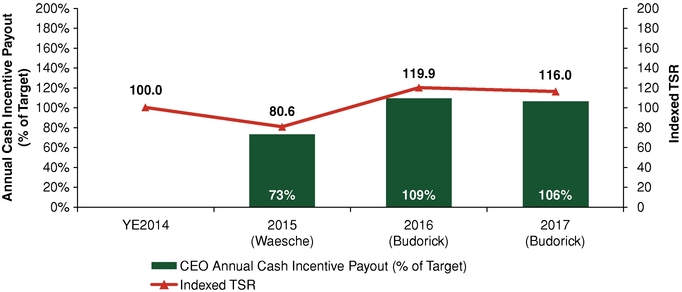
Long-Term Equity Incentive Awards We design our long-term equity incentive awards to align the interests of the executives with those of our shareholders by rewarding them for sustained performance. Since these awards vest over time, they also encourage the executives to remain with the Company. We award long-term equity incentives in two components: PSUs and RSs. NEOs earn the PSU component entirely as a function of the Company's TSR performance over a forward-looking three-year period in comparison to peers. The Committee believes that awarding a majority of the executive long-term equity incentive awards using PSU grants provides for the following:•Executive and shareholder risks and rewards are more closely aligned by a long-term, forward-looking plan focused on relative TSR;•Retention of key executives is enhanced due to the payout opportunities available in the event of superior relative performance;•Grants and potential awards under the plan are clearly determined and communicated to the NEOs at the beginning of the performance period; and•Dividends are accrued but not paid out on the PSUs until, and to the extent, they are earned at the end of thefollowing terms shall be defined performance period, thus putting additional compensation at risk based on performance.We make the remainder of the executives' long-term incentive awards in the form of RSs to provide an element of retention to our plan. In 2017, the Board awarded long-term equity incentive grants to NEOs that consisted of 60% PSUs and 40% RSs. The 2017 award program continues to deliver the majority of annual long-term incentive awards in the form of performance-based equity, demonstrating our Board's belief that these awards underscore our objectives of aligning management and shareholder interests while emphasizing our goal of retention.PSU Awards Made in 2017 On January 1, 2017, the Board granted PSUs as set forth below, at 60%below:respective individuals' long-term equity incentive award. Base Salary
Used for
Equity Award Total Target
Equity Award
as a % of
Base
Salary(1) PSU % of
Total
Target Equity Value of
PSUs
Awarded Number of
PSUs
Awarded $ 561,600 250 % 60 % $ 842,424 21,921 $ 400,000 125 % 60 % $ 300,023 7,807 $ 378,525 115 % 60 % $ 261,209 6,797
“Award” or “Awards,” means an award under the Plan and, except where referring to a particular category of grant under the Plan, shall include Incentive Options, Non-Qualified Options, Share Appreciation Rights, Restricted Share Unit Awards, Restricted Share Awards, Unrestricted Share Awards, Cash-Based Awards, Dividend Equivalent Rights, Units and other equity-based Awards as contemplated herein.(1)Based on“Award Certificate” means a reviewwritten or electronic document setting forth the terms and provisions applicable to an Award granted under the Plan. Each Award Certificate is subject to the terms and conditions of peer compensation data related to long-term equity incentives,the Plan.approved increasing Mr. Budorick's total target long-term equity award percentage of base salary from 225% to 250%, Mr. Adkins' from 115% to 125% and Mr. Mifsud's from 100% to 115% for awards made in January 2017. We developed these target award percentages using a broad perspective and multiple data points, including: (1) peer long-term equity award data; (2) the Company's desire to differentiate between NEOs; and (3) the total target compensation to be delivered to NEOs. The number of PSUs granted was derived by dividing the valueTrustees of the award byCompany.value of each PSU. The value of each PSU was determined using a Monte Carlo simulation of our share price for the performance period January 1, 2017 through December 31, 2019. These grants have a performance period beginning on January 1, 2017 and concluding the earlier of: (1) December 31, 2019; (2) the date of termination by the Company without cause, the death or disability of the executive, or the constructive discharge of the executive (collectively, "qualified termination"); or (3) a change in control of the Company. The Committee seeks to align executive pay programs with shareholder benefit and, for this reason, evaluated performance-based equity programs to ensure that the plan features optimally incent our executives in correlation with shareholder benefit. On August 23, 2017, the January 2017 grants were modified to include a provision that limits the earned PSU payout percentage to 100% of the PSUs granted if COPT's total shareholder return is negative during the performance period irrespective of its percentile rank in the peer group (the "Negative TSR Modifier"). In addition, because of the modification to the January grants, on August 23, 2017 we augmented the January grants by issuing an aggregate of 2,826 additional PSUs to the NEOs. The incremental award to the NEOs on August 23, 2017 resulting from these modifications totaled $11,671. On November 8, 2017, the Committee approved a refinement to comparator company treatment in the event a peer company ceases trading, to stabilize the performance comparison using the TSR of an index in the place of a peer for which trading has ceased, resulting in an aggregate incremental award value of $223,881. No additional units were granted in November 2017. The incremental fair value for both the August 23, 2017 and November 8, 2017 PSU modifications was based on the difference between the pre-modification and post-modification award fair value on the respective modification dates. The actual number of shares that the Company will distribute at the end of the performance period ("earned PSUs") will be determined based on the percentile rank of the Company's TSR relative to those of the companies in the 2017 peer group, as set forth in the following schedule, with interpolation between points:Percentile RankEarned PSUs Payout %75th or greater200% of PSUs granted50th100% of PSUs granted25th50% of PSUs grantedBelow 25th0% of PSUs granted At the end of the performance period, the Company, in settlement of the award, will issue a number of fully-vested common shares equal to the sum of: (1) the number of earned PSUs in settlement of the award plan; and (2) the aggregate dividends that would have been paid with respect to the common shares issued in settlement of the earned PSUs through the date of settlement had such shares been issued on the grant date, divided by the average of the closing price of our common shares for the 15 days trailing up to the issuance date. The Company will pay the dividend equivalent component of the August grant described above in cash. PSUs do not carry voting rights. With regard to prior year PSU awards, the performance period for the March 2015 PSU grant ended on December 31, 2017. The Company's TSR over the three-year performance period ranked at the 38th percentile relative to our peers' TSR, resulting in a payout of 75% of the target award to Mr. Budorick and Mr. Mifsud in 2018 for that plan. If a performance period ends due to a change in control or qualified termination, the PSU program terminates and any payout to the executives is prorated based on the portion of the three-year performance period that has elapsed. We believe that this feature of the PSU program is appropriate as it essentially compensates our executives only for the time worked and the results achieved to date. If employment is terminated by the employee or the Company for cause, all PSUs are forfeited.RS Awards Made in 2017 In November 2016, the Board approved grants awarded March 1, 2017 of RSs to the NEOs valued at 40% of the executives' target equity award percentages as set forth below: Base Salary
Used for
Equity
Award Total Target
Equity Award
as a % of Base
Salary(1) RS % of
Total Target
Equity Value of
RSs
Awarded Number of
RSs
Awarded $ 561,600 250 % 40 % $ 561,602 16,508 $ 400,000 125 % 40 % $ 200,004 5,879 $ 378,525 115 % 40 % $ 174,114 5,118 (1)Based on a review of peer compensation data related to long-term equity incentives, the Board approved increasing Mr. Budorick's total target long-term equity award percentage from 225% of base salary to 250% of his base salary, Mr. Adkins' from 115% to 125% and Mr. Mifsud's from 100% to 115% for awards made in January 2017. RSs vest in equal one-third increments annually over a three-year period, provided that the individual remains employed by the Company. The Company has not issued stock options since 2009 and the Company has not issued stock options to any of our current NEOs. The Company has never issued stock appreciation rights.Pay for Performance and Compensation Program Highlights for 2018: Based on the Company's commitment to align pay and performance, the following actions will occur or have already occurred for 2018:•The 2018 annual cash incentive award plan will use the company performance scorecard measurement process with emphasis on key business growth drivers and a continued focus on the achievement of financial and operational goals.•Based on a review of peer compensation data related to long-term equity incentive awards, the Board approved increasing NEO target long-term equity award percentages for 2018, as a percentage of base salary, from 250% to 275% for Mr. Budorick; from 125% to 145% for Mr. Adkins; and from 115% to 135% for Mr. Mifsud.•The Company will continue to provide the majority of our NEOs' long-term equity awards in the form of PSUs, and the balance will be in the form of RSs. The Company has awarded Mr. Budorick, Mr. Adkins and Mr. Mifsud long-term equity incentive grants in the form of 60% PSUs (awarded on January 1, 2018) and 40% RSs (awarded on March 1, 2018). We believe this form of compensation aligns with industry practice and strengthens the retention aspect of our program while continuing to deliver the majority of annual long-term incentive awards in the form of performance-based equity.•Following the completion of our annual peer group review and the sale of First Potomac Realty Trust, we determined that the remaining 14 companies from the 2017 peer group were appropriate comparators; therefore the Committee approved this peer group to be used for 2018. Management and the Committee believe that this peer group reflects our office, diversified and specialty REIT emphasis and provides more comparability to companies with which we compete for talent, capital and market share.Retirement Benefits We design our retirement benefits to assist our executives in accumulating sufficient wealth to provide income during their retirement years. We intend the retirement benefits to attract and retain executives and to encourage such executives to save money for their retirement, while allowing us to maintain a competitive cost structure. Information pertaining to our retirement benefits is set forth below.401(k) Plan Our executives participate in a 401(k) defined contribution plan covering substantially all of our employees. The plan provides for Company matching contributions in an amount equal to an aggregate of 3.5% on the first 6% of participant pre-tax and/or after tax contributions to the plan. Effective January 1, 2018, we increased the 401(k) match to 4% on the first 6% of participant contributions to the plan.Nonqualified Deferred Compensation Plan We offer our senior management team (director level and above), as well as our Trustees, a nonqualified deferred compensation plan. This plan allows for the deferral of up to 100% of a participant's cash compensation on a pre-tax basis and enables such participantsrecipient to receive a tax-deferred return on such deferrals. Both senior management and Trustees may elect to defer their salary/board fees during a December enrollment period (for the following year's salary/board fees). Participants may diversify their investments among the plan's selected investment alternatives, including mutual funds and brokerage accounts. The plan does not guarantee a return or provide for above-market preferential earnings. The plan is not qualified under the Employee Retirement and IncomeSecurity Act of 1974. The deferral account balances increase or decrease in value based on the performance of the investments selected by the participants. Participants in this plan defer their payments for at least three years from the beginning of the calendar year following the year in which he or she elects the deferral. Participants may choose to receive account balances in a lump sum or annual installments either upon separation or at a specified future date. For participants who separate from service, payments according to their election(s) will commence within 60 days of separation unless the participant is a "specified employee," as defined in the plan, in which case any distribution shall not be made for six months from termination. For participants who elected specified future payment dates, those payments will commence on the chosen dates. Payments are due to parties designated by the participant in lump sum upon the death of a participant. Participant account balances are fully vested at all times and participation in the deferred compensation plan is voluntary. None of our current NEOs participate in our deferred compensation plan.Severance and “Change in Control Benefits The Company does not enter into executive employment agreements with our NEOs. Consistent with best practice, the Company utilizes a Change in Control ("CIC") Plan. The CIC Plan provides for a severance package in the event of the termination of the executive's employment (1) within 12 months of a change in control of the Company, as defined in the CIC Plan or (2) by us without cause or by the employee based upon constructive discharge. The CIC Plan participants must agree to certain non-competition, non-solicitation and confidentiality covenants, and must deliver a release of claims in order to receive payments and benefits under the CIC Plan. We believe that the CIC Plan affords our executives with financial security in the event of a change in control, while ensuring that the Company is able to retain the appropriate knowledge and expertise needed during this situation. We also believe that having the CIC Plan encourages the continued dedication of the executives evaluating potential transactions involving the Company, which might result in a change in control. Due to the authority vested with the executives and the knowledge of Company proprietary information held by such individuals, the Company must protect its real estate interests in each of its major markets. For this reason, the CIC Plan includes a non-compete provision for a 12-month period following termination of employment. The CIC Plan also requires delivery of a release of claims against the Company and related parties in order to be eligible to receive severance payments under such agreement.Other Benefits and Perquisites As employees, our executives are eligible to participate in employee benefit programs available to our other employees, including medical, dental, life and disability insurance, as well as participation in an Executive Wellness Program. As with all other employees of the Company, our executives also receive a monetary award for achieving service anniversary milestones. The value of these benefits that executives may receive is essentially equivalent to that offered to the broader management and/or employee group and is included in the tables entitled "Summary Compensation Table" and "All Other Compensation." As demonstrated by the provisions of our CIC Plan, we do not enter into agreements that contain perquisites that may be considered poor pay practices.Tax Compliance Policy The Compensation Committee considers the tax and accounting treatment associated with cash and equity awards it makes. Except for performance-based compensation that meets certain requirements, Section 162(m) of the Internal Revenue Code of 1986, as amended (the "Code"), places a limit of $1 million on the compensation that may be paid to certain highly compensated executive officers. We believe that the limitation of Section 162(m) of the Code does not apply to most of the compensation we paid to our NEOs for 2017 and only a small portion of their compensation may notbe deductible due to that limitation. With the exception of certain grandfathered awards made pursuant to a written binding contract in effect on November 2, 2017, the Tax Cuts and Jobs Act, which became law on December 22, 2017, amended Section 162(m) to eliminate the performance-based compensation exception effective January 1, 2018. Section 409A of the Code provides that amounts deferred under nonqualified deferred compensation plans are includable in an employee's income when no longer subject to a substantial risk of forfeiture unless certain requirements are met. If the requirements under Section 409A of the Code are not met, an employee could be subject to additional taxes, interest and penalties. The Company, with the assistance of external counsel, continuously reviews all its various executive compensation and benefits plans and arrangements to ensure compliance with Section 409A of the Code. Under Sections 280G of the Code, a corporation will be denied an income tax deduction on any "excess parachute payments" made to certain executives in connection with a change in control, and the executives receiving such excess parachute payments will be subject to a non-deductible 20% excise tax, in addition to regular federal and state income tax. The Compensation Committee considers the impact of Section 280G of the Code on our compensation plans and arrangements with our NEOs and none of these plans provide for an excise tax gross-up pursuant to Section 280G of the Code.Executive Ownership and Capital Accumulation We believe that the ownership of shares in the Company by NEOs assists in aligning their interests with those of our shareholders. Therefore, we have the following share ownership guidelines for our Trustees and NEOs:RoleValue of Common Shares to be OwnedTrustees3 times annual retainerChief Executive Officer6 times base salaryPresident (if separate from the CEO)3 times base salaryChief Financial Officer3 times base salaryChief Operating Officer3 times base salary The ownership guidelines generally include common shares beneficially owned by the respective individuals, including unvested RSs, certain share equivalents under Company sponsored plans and units in the Company's Operating Partnership owned by such individuals, although the guidelines exclude outstanding stock options, PSUs, and any shares or securities that are pledged as collateral for a loan. For Trustees in office as of March 1, 2009, the effective date of these ownership guidelines was March 1, 2009. For those individuals, the share ownership goal was determined using their retainers or base salaries in effect, and the common share price, as of that date. The share ownership goal under the ownership guidelines for persons assuming a Trustee or executive level position after March 1, 2009 was determined using their retainers or base salaries as of the date they become subject to the ownership guidelines and the average closing price of our common shares on the NYSE for the 60 trading days prior to such date. Once established, a person's share ownership goal did not change because of changes in his retainer or base salary or fluctuations in our common share price. An individual's share ownership goal was only re-established upon a change to a different executive position. Generally, individuals had a five-year period to attain their share ownership goals. If an individual's share ownership goal increased because of a change in position, a five-year period to achieve the incremental amount of shares would begin on the effective date of the change in position. Effective February 22, 2018, the Company implemented new share ownership guidelines for Trustees and executive level positions. Under these new guidelines, each Trustee is required to own shares in the Company with a value equal to at least five (5) times the annual cash retainer for servingas a member of the Board. The Chief Executive Officer is required to own shares in the Company with a value equal to at least six (6) times his annual base salary. The Chief Operating Officer and the Chief Financial Officer are each required to own shares in the Company with a value equal to at least three (3) times their respective annual base salaries. Individuals will have a five-year period commencing February 22, 2018 to attain their respective share ownership goals.Trading Controls We require our executives and Trustees to receive the permission of our General Counsel and Secretary prior to entering into transactions in Company shares or share equivalents. Executives and Trustees are subject to blackout periods on the trading of Company shares for a period of time beginning at each quarter-end and a period following the release of earnings for each quarter-end. Executives and Trustees bear full responsibility if they violate the Company Policy Statement on Securities Trading by permitting shares to be bought or sold without pre-approval by our General Counsel or when trading is restricted. The Policy Statement on Securities Trading also specifically prohibits NEOs and Trustees from participating in any hedging activities in Company shares. The Company also has an anti-pledging policy. Subject to the terms of the policy, executives may notControl” means (i) hold securities of the Company in a margin account or pledge securities of the Company as collateral for a loan, or (ii) enter into hedging or monetization transactions or similar arrangements with respect to securities of the Company. We reviewed the elements of executive and non-executive compensation to determine whether they encourage excessive or unintended risk-taking and concluded that:•significant weighting toward long-term equity compensation discourages short-term risk taking;•vesting schedules for restricted shares and PSUs cause management to have a significant amount of unvested awards at any given time, which creates longer term perspectives and focus;•performance goals are set based on a business plan approved by the Board and their achievement does not automatically entitle management to annual cash incentive awards or equity awards, which are at the discretion of the Board;•the Board exercises approval rights over significant investment decisions that could expose the Company to long-term risks;•share ownership guidelines require management to hold a certain amount of our stock such that the NEOs' interests are aligned with shareholders; and•our clawback policy allows the Company to recoup incentive awards paid to executives and certain other key employees in the event such recoupment is warranted.Accordingly, our executives and Board concluded that risks arising from our policies and practices for compensating employees are not reasonably likely to have a material adverse effect on the Company. The following table summarizes the compensation earned in 2017, 2016 and 2015 by our NEOs. Year Salary Bonus(1) Share-Based
Compensation
Awards(2) Non-Equity
Incentive Plan
Compensation(3) All Other
Compensation(4) Total 2017 $ 560,354 $ — $ 1,556,743 $ 742,014 $ 9,450 $ 2,868,561 2016 $ 506,415 $ 73,635 $ 1,215,016 $ 607,066 $ 9,549 $ 2,411,681 2015 $ 438,700 $ — $ 615,976 $ 506,000 $ 9,275 $ 1,569,951
2017
$
400,000
$
—
$
507,989
$
488,175
$
6,963
$
1,403,127 2016 $ 15,385 $ 300,000 $ 417,965 $ — $ — $ 733,350
2017
$
377,889
$
—
$
510,196
$
402,845
$
9,962
$
1,300,892 2016 $ 366,558 $ 35,280 $ 367,519 $ 359,783 $ 9,275 $ 1,138,415 2015 $ 335,408 — $ 954,198 $ 350,000 $ 10,727 $ 1,650,333 (1)The amounts included in this column Messrs. Budorick and Mifsud represent additional discretionary cash amounts awarded in 2017 above the awards determined by actual performance against the pre-established performance objectives for 2016. The amount included in this column for Mr. Adkins represents a signing bonus agreed to by the Company at the commencement of his employment; this payment is subject to recoupment by the Company ratably over a three-year period from his start date should Mr. Adkins terminate his employment within that period.(2)Represents the grant date fair value of PSUs and RSs awarded during the calendar year. In addition, amounts for 2017 also included the incremental fair value associated with modifications of certain provisions of PSUs as discussed further in the section above entitled "Long-Term Equity Incentive Awards." The settlement value of the PSU awards, if any, will be realized by the executive at the end of the defined performance period based on relative total shareholder return over such period of performance. See Notes 2 and 15 to the Company's consolidated financial statements included in the Company's Annual Report for the year ended December 31, 2017 for additional information regarding PSUs and RSs.(3)Represents annual cash incentive awards paid in 2018, 2017 and 2016 determined by actual performance against the pre-established Company and individual performance objectives as compensation for services performed during 2017, 2016 and 2015, respectively.(4)Refer to the table below entitled "All Other Compensation" for details on these amounts, which include auto allowances and personal financial and tax preparation fees paid by the Company on behalf of the officers, Company match on employee contributions to the Company's 401(k) and nonqualified deferred compensation plans, employment separation payments and milestone service awards received for attaining a certain length of employment with the Company under a program available to the Company's other employees.(5)On May 12, 2016, Mr. Budorick, who was serving as Executive Vice President and COO, was promoted to President and CEO.(6)Mr. Adkins was appointed as Executive Vice President and Chief Operating Officer effective November 28, 2016. Year Matching of
Contributions
to 401(k)
Plans Other Total 2017 $ 9,450 $ — $ 9,450 2016 $ 9,275 $ 274 $ 9,549 2015 $ 9,275 $ — $ 9,275 2017 $ 6,912 $ 51 $ 6,963 2016 $ — $ — $ — 2017 $ 9,450 $ 512 $ 9,962 2016 $ 9,275 $ — $ 9,275 2015 $ 9,275 $ 1,452 $ 10,727 2017 Grants of Plan-Based Awards The following table sets forth information about equity and non-equity awards granted to the NEOs for 2017. All Other
Stock
Awards:
Number of
Shares of
Stock (#)(4) Estimated Possible
Payouts Under Non-Equity
Incentive Plan Awards ($)(2) Estimated Possible Payouts
Under Equity Incentive
Plan Awards (#)(3) Grant Date
Fair Value
of Stock
Awards ($)(3)(4)(5) Grant
Type Grant
Date(1) Threshold Target High Threshold Target Maximum Annual 351,000 702,000 1,053,000 PSU 1/1/2017 10,961 21,921 43,842 842,424 PSU 8/23/2017 848 1,696 3,392 7,004 PSU 11/8/2017 — — — 145,713 Restricted 3/1/2017 16,508 561,602
230,000
460,000
690,000 PSU 1/1/2017 3,904 7,807 15,614 300,023 PSU 8/23/2017 302 604 1,208 2,495 PSU 11/8/2017 — — — 5,467 Restricted 3/1/2017 5,879 200,004
189,263
378,525
567,788 PSU 1/1/2017 3,399 6,797 13,594 261,209 PSU 8/23/2017 263 526 1,052 2,172 PSU 11/8/2017 — — — 72,701 Restricted 3/1/2017 5,118 174,114 (1)November 9, 2016 is the date on which the Board established the range of potential cash annual incentive awards for 2017 performance by NEOs employed on January 1, 2017. All 2017 PSU and RS grants were made following the establishment of the range of potential cash incentive awards under the long-term equity incentive program for certain NEOs employed as of that date. See the section entitled "Long-Term Equity Incentive Awards" for a discussion of 2017 PSU modifications that resulted in incremental value reflected above on August 23, 2017 and November 8, 2017.(2)As described in the section entitled "Compensation Discussion and Analysis," the Board approved annual cash incentive awards for the NEOs, as a percentage of base salary, for three levels of aggregate performance. These columns show the estimated future payouts of annual incentive awards for the three aggregate levels of performance approved by the Board for 2017, as converted from the percentages of 2017 base salary.(3)The Target column reflects the PSU awards made under the long-term incentive plan granted by the Board effective on the dates indicated in the Grant Date column. The Threshold and Maximum columns reflect the estimated payout at those levels as indicated by the terms of the PSU award agreements described in the section of this proxy statement entitled "Compensation Discussion and Analysis." The actual awards issued will be a function entirely of the Company's TSR performance over the defined performance period in comparison to peers. At the end of the performance period, the Company, in settlement of the award, will issue a number of fully-vested common shares equal to the sum of: (1) the number of earned PSUs in settlement of the award plan; and (2) the aggregate dividends that would have been paid with respect to the common shares issued in settlement of the earned PSUs through the date of settlement had such shares been issued on the grant date, divided by the average closing price of our common shares for the 15 days trailing up to the issuance date, as defined under the terms of the agreement. The August grant's dividend equivalent component will be paid in a cash.(4)This column reflects the RSs granted under the long-term incentive plan. The shares granted to the NEOs vest as the individual remains with the Company in equal one-third installments annually over a three-year period.(5)The grant date fair value of PSUs on January 1, 2017 was $38.43 per PSU as calculated using a Monte Carlo model, which included assumptions of, among other things, the following: baseline common share value of $31.22; expected volatility for our common shares of 19.0%; and risk-free interest rate of 1.47%. The grant date fair value of RSs granted on March 1, 2017 was calculated using the closing common share price on the NYSE of $34.02. The incremental fair value of the PSU modifications is based on the difference between the pre-modification and post-modification award fair value on the date of modification.Outstanding Equity Awards at December 31, 2017 The table below provides information about unvested RSs and unsettled PSUs as of December 31, 2017 for the NEOs. None of our NEOs held any options to purchase common shares as of that date. Stock Awards Grant Date Number of
Shares
That
Have Not
Vested(1) Market Value
of Shares
That
Have Not
Vested ($)(2) Equity
Incentive
Plan Awards:
Number of
Unearned
Units(3) Equity
Incentive
Plan Awards:
Market or
Payout Value
of Unearned
Units ($)(4) 3/5/2015 2,805 81,906 8,393 245,061 3/1/2016 13,557 395,864 10,259 299,548 1/1/2017 — — 11,374 332,106 3/1/2017 16,508 482,034 — — 8/23/2017 — — 880 25,696
12/1/2016
11,720
342,224
—
— 1/1/2017 — — 4,051 118,275 3/1/2017 5,879 171,667 — — 8/23/2017 — — 313 9,140
2/4/2015
20,000
584,000
—
— 3/5/2015 1,595 46,574 4,769 139,248 3/1/2016 4,101 119,749 3,103 90,593 1/1/2017 — — 3,527 102,974 3/1/2017 5,118 149,446 — — 8/23/2017 — — 273 7,972 (1)This column represents the number of RSs awarded. The forfeiture restrictions on these awards that were unvested on December 31, 2017 lapsed or will lapse on the following dates:a.Granted 2/4/2015—60% is scheduled to vest on 4/1/2018 and 20% vests on each of 4/1/2019 and 4/1/2020.b.Granted 3/5/2015—100% of the awards vested on 3/5/2018.c.Granted 3/1/2016—50% of the award vested on 3/1/2018 and the remaining 50% is scheduled to vest on 3/1/2019.d.Granted 12/1/2016—25% of the remaining quantity is scheduled to vest on each of 12/1/2018, 12/1/2019, 12/1/2020 and 12/1/2021.e.Granted 3/1/2017—One-third vested on 3/1/2018 and one-third is scheduled to vest on each of 3/1/2019 and 3/1/2020.(2)This column represents the value of the RSs awarded. The value is calculated by multiplying the number of shares subject to vesting or issuable by $29.20, the closing price of our common shares on the NYSE on December 29, 2017, the last trading day of 2017.(3)The amount reported in this column represents the number of common shares that would be issuable in settlement of the PSUs at the threshold level of performance (except for the PSUs with a March 5, 2015 grant date, which was based on an actual payout of 75% of the award target, as such amount was determinable as of December 31, 2017), including the effect of aggregate dividends declared through December 31, 2017. The PSUs have a performance period beginningon January 1, 2015, January 1, 2016 and January 1, 2017 (applicable to both the January 1, 2017 and August 23, 2017 awards), respectively, and concluding on the earlier of: (1) December 31, 2017, December 31, 2018 and December 31, 2019 (applicable to both the January 1, 2017 and August 23, 2017 awards), respectively; (2) the date of termination by the Company without cause, the death or disability of the executive or the constructive discharge of the executive (collectively, "qualified termination"); or (3) the date of a sale event. At the end of the performance period, the Company, in settlement of the award, will issue a number of fully-vested common shares equal to the sum of: (1) the number of earned PSUs in settlement of the award plan; and (2) the aggregate dividends that would have been paid with respect to the common shares issued in settlement of the earned PSUs through the date of settlement had such shares been issued on the grant date, divided by the average of the closing price of our common shares for the 15 days trailing up to the issuance date, as defined under the terms of the agreement. The August 23, 2017 grant's dividend equivalent component will be paid in cash.(4)This column represents the market value of the PSU awards. The value is calculated by multiplying the number of common shares that would be issuable in settlement of the PSUs at the threshold level of performance (except for the PSUs with a March 5, 2015 grant date, which was based on an actual payout of 75% of the award target, as such amount was determinable as of December 31, 2017), as reported in the previous column, by $29.20, the closing price of our common shares on the NYSE on December 29, 2017. The table below provides information about the value realized on RSs vesting during 2017 for the NEOs. Number of
Shares
Acquired
on Vesting Value Realized
on Vesting(1) 12,186 $ 414,285 2,930 $ 88,896 5,595 $ 190,399 (1)Value realized on vesting of RSs is calculated by multiplying the closing price of our common shares as reported by the NYSE on the day before the vesting date by the number of shares vesting.Nonqualified Deferred Compensation Our current NEOs do not participate or have balances in the nonqualified deferred compensation plan. We are required by the SEC to disclose the ratio of the total 2017 compensation of our CEO, Mr. Budorick, to the annual compensation for 2017 of our median employee. We selected our median employee based on the 374 full- and part-time employees, excluding Mr. Budorick, employed as of December 31, 2017. We calculated the annual total compensation of all employees using W-2 and employee record information without any cost of living adjustments, and included the following compensation elements: salary, including overtime; non-equity incentive plan compensation; share-based compensation awards; bonus payments; and the elements disclosed in the All Other Compensation table for our NEOs. Per the Summary Compensation Table, Mr. Budorick's total compensation in 2017 was $2,868,561 and the median employee's was $99,168. The ratio of Mr. Budorick's total 2017 compensation to the total annual compensation for 2017 of our median employee is 28.9 to 1.Potential Payments on Termination, Change in Control, Death or Disability The CIC Plan provides for the following severance package in the event of termination of the covered executive's employment (1) within 12 months of a change in control of the Company or (2) by us without cause or by the executive based upon constructive discharge:•severance payment equal to the sum of (A) current annualized base salary plus (B) the average of the three most recent annual incentive awards, multiplied by 2.99 if due to change in control or 1.0 (or in the case of our CEO, 2.0) if due to termination without cause or constructive discharge;•a pro-rated annual incentive cash bonus for the year of termination;•continued medical, dental and vision benefits for 12 months following termination unless such benefits are available through other employment after termination;•full vesting of previously unvested options, restricted shares and other equity awards subject to time-based vesting with the right to exercise options for up to 18 months following termination; and•vesting of performance-based equity awards in accordance with the terms of the applicable award agreements. We believe that the termination of the PSU program upon a change in control resulting in a pro-rata payout based on the portion of the performance period completed essentially compensates our executives only for the time worked and the results achieved to the date of the change in control. The severance payments will be paid in substantially equal monthly installments over 12 months, or if as a result of a change in control, severance will be paid in a lump sum. Such payments will be made in accordance with the provisions of Section 409A of the Internal Revenue Code, and do not provide for any gross-up on excise taxes. Under the CIC Plan, a termination by us without cause is termination of employment for any reason other than (1) termination upon disability; or (2) a "for-cause" termination. A "for-cause" termination is the termination of employment by us on the basis or as a result of (i) an executive's conviction or disposition other than "not guilty" of a felony, a crime of moral turpitude or any crime in connection with any financial, business or commercial enterprise or transaction; (ii) a final judgment or other finding by a federal or state court or federal or self-regulatory agency that an executive has committed an intentional or reckless violation of security laws; (iii) any actions engaged in by an executive constituting a violation of law, dishonesty, bad faith or willful disregard of duties in connection with the executive's services with respect to the Employer; (iv) any act of willful misconduct committed by an executive directly or indirectly related to the executive's employment or services with respect to the Company, including but not limited to, misappropriation of funds, dishonesty, fraud, unlawful securities transactions or a material violation of the Company's Code of Business Conduct and Ethics or the Code of Ethics for Financial Officers; or (v) the willful or negligent failure of an executive to perform his duties hereunder, which failure continues for a period of thirty (30) days after written notice thereof is given to the executive. Under the CIC Plan, constructive termination is termination initiated by the individual upon being "constructively discharged" by us, which means the occurrence of any of the following events (not in connection with a "for-cause" termination): (1) an executive is not re-elected to, or is removed from his position with the Company, other than as a result of the executive's election or appointment to positions of equal or superior scope and responsibility; or (2) a material diminution in an executive's responsibilities, authority or duties; or (3) the Company otherwise commits a material breach of its obligations under these agreements; or (4) the Company changes the primary employment location ofthe executive to a place that is more than fifty (50) miles from 6711 Columbia Gateway Drive, Columbia, Maryland. Under the CIC Plan, a change in control means the occurrence of any of the following during the term of the plan: (1) the consummation of the acquisition by any person (as such term is defined in Section 13(d) or 14(d) of the Exchange ActAct) of beneficial ownership (within the meaning of Rule 13d-3 promulgated under the Exchange Act) of 50%50 percent or more of the combined voting power embodied in the then outstanding voting securities of the Company or the employee's employer; (2)Company; (ii) the consummation of: (a) a merger or consolidation of the Company, or the employee's employer, if the shareholders of the Company or the employer of the employee immediately before such merger or consolidation do not, as a result of such merger or consolidation, own, directly or indirectly, more than 50%50 percent of the combined voting power of the then outstanding voting securities of the entity resulting from such merger or consolidation in substantially the same proportion as was represented by their ownership of the combined voting power of the voting securities of the Company or the employee's employer outstanding immediately before such merger or consolidation; or (b) thea sale or other disposition of all or substantially all of the assets of the Company orCompany; (iii) the employer of the employee; or (3) approval by the shareholders of the Company or the employer of the employee of a completedissolution or substantial liquidation or dissolution of the Company or the employer of the employee. The table below reflects the payments that would be made to the NEOs pursuant to the provisions discussed above, assuming that the applicable termination event described occurred on December 31, 2017. Cash
Severance
Payments Continuation
of Medical/
Welfare
Benefits(1) Value of
RS
Vestings(2) Value of
PSU
Vestings(3) Total
Termination
Benefits $ 1,115,867 $ 16,304 $ 959,804 $ 932,551 $ 3,024,526 $ 2,145,397 $ 16,304 $ 959,804 $ 932,551 $ 4,054,056 $ — $ — $ 959,804 $ 932,551 $ 1,892,355
$ 860,000 $ 15,678 $ 513,891 $ 56,102 $ 1,445,671 $ 2,571,400 $ 15,678 $ 513,891 $ 56,102 $ 3,157,071 $ — $ — $ 513,891 $ 56,102 $ 569,993
$ 670,213 $ 16,304 $ 899,769 $ 283,273 $ 1,869,558 $ 1,581,041 $ 16,304 $ 899,769 $ 283,273 $ 2,780,386 $ — $ — $ 899,769 $ 283,273 $ 1,183,041 (1)These benefits were computed based on the monthly medical and welfare benefits for the named executive officers as of December 31, 2017 multiplied by the number of months over which such benefits are to continue beyond such executives' employment termination.(2)Value of a RS vesting is calculated by multiplying the number of shares subject to vesting as of December 31, 2017 by $29.20, the closing price of our common shares on the NYSE on December 29, 2017.(3)Value of PSU vestings is calculated by multiplying the number of common shares that would be issuable in settlement of unvested PSUs (including the effect of aggregate dividends declared through December 31, 2017) by $29.20, the closing price of our common shares on the NYSE on December 29, 2017. The number of shares issuable in settlement would be prorated based on the portion of the three-year performance period that has elapsed in the event of a change in control.Equity Compensation Plan Information The table below provides information as of December 31, 2017 regarding our compensation plans under which equity securities are authorized for issuance to employees or non-employees in exchange for consideration in the form of goods and services. Number of Securities to
be Issued Upon Exercise
of Outstanding Options,
Warrants and Rights
(a) Weighted-average
Exercise Price of
Outstanding Options,
Warrants and Rights
(b) Number of Securities
Remaining Available for
Future Issuance Under
Equity Compensation
Plans (Excluding
Securities in Column (a))
(c) 248,931 (1) $ 35.17 (2) 3,372,543 (3) — N/A — 248,931 $ 35.17 3,372,543 (1)Includes the following:a.148,226 shares issuable pursuant to 79,958 PSUs outstanding as of December 31, 2017. The 148,226 shares includes 134,898 shares that would be issuable in settlement of 64,201 unvested PSUs at the maximum level of performance plus 13,328 shares issuable in settlement of 15,767 vested but unsettled PSUs based on an actual payout of 75% of the award target, as such amount was determinable as of December 31, 2017; these amounts include the effect of aggregate dividends declared through December 31, 2017.b.40,705 shares issuable pursuant to outstanding deferred share awards (10,032 of which were unvested as of December 31, 2017); andc.60,000 common shares subject to outstanding options (all of which were vested and exercisable).(2)Because there is no exercise price associated with PSUs or deferred share awards, these awards are not included in the weighted-average exercise price calculation.(3)Represents shares available for issuance under the 2017 Omnibus Equity Incentive Plan after reserving for shares issuable pursuant to outstanding PSU and deferred share awards included in column (a) of the table above. CORPORATE OFFICE PROPERTIES TRUSTARTICLES OF AMENDMENTTHIS IS TO CERTIFY THAT:FIRST: The Amended and Restated Declaration of Trust of Corporate Office Properties Trust, a Maryland real estate investment trust (the "Trust"), is hereby amended by deleting Article XI of the Amended and Restated Declaration of Trust in its entirety and replacing it with the following:"ARTICLE XIMERGER, CONSOLIDATION OR SALE OF TRUST PROPERTYSubject to the provisions of any class or series of Shares at the time outstanding, the Trust may (a) merge the Trust into another entity, (b) consolidate the Trust with one or more other entities into a new entity or (c) sell, lease, exchange or otherwise transfer all or substantially all of the Trust Property.Company’s assets or (iv) the members of the Board at the beginning of any consecutive 24-calendar-month period (the “Incumbent Trustees”) cease for any reason to constitute at least a majority of the members of the Board; provided that any member of the Board whose election, or nomination for election by the Company’s shareholders, was approved by a vote of at least a majority of the Incumbent Trustees, shall be deemed to be an Incumbent Trustee; provided further, however, that no individual initially elected or nominated as a member of the Board as a result of an actual or threatened election contest with respect to the members of the Board or as a result of any other actual or threatened solicitation of proxies by or on behalf of any person other than the Board shall be deemed to be an Incumbent Trustee.B-1 COPT Defense Properties 

2024 Proxy Statement B-2 B-3 COPT Defense Properties 

2024 Proxy Statement B-4 B-5 COPT Defense Properties 

2024 Proxy Statement B-6 B-7 COPT Defense Properties 

2024 Proxy Statement B-8 B-9 COPT Defense Properties 

2024 Proxy Statement B-10 B-11 COPT Defense Properties 
and, after notice to all shareholders entitled to voteof Corporate Office Properties Trust on the matter, by the affirmative vote of a majority of all the votes entitled to be cast on the matter."SECOND: The amendment to the Amended and Restated Declaration ofdate first written above. as set forth above has been duly advised by the board of trustees of the Trust and approved by the shareholders by the affirmative vote of at least two-thirds of all the votes entitled to be cast on such amendment.THIRD: The undersigned and& Chief Executive Officer acknowledges these Articles of Amendment to be the corporate act of the Trust and as to all matters or facts required to be verified under oath, the undersigned President and Chief Executive Officer acknowledges that to the best of the President and Chief Executive Officer's knowledge, information and belief, these matters and facts are true in all material respects and that this statement is made under the penalties for perjury. IN WITNESS WHEREOF, the Trust has caused these Articles to be signed in its name and on its behalf by its President and Chief Executive Officer and attested to by its Secretary on this day of May, 2018.ATTEST:
2024 Proxy Statement CORPORATE OFFICE PROPERTIES TRUSTa Maryland real estate investment trustBy:(SEAL)David L. Finch,SecretaryStephen E. Budorick,President and Chief Executive OfficerC-1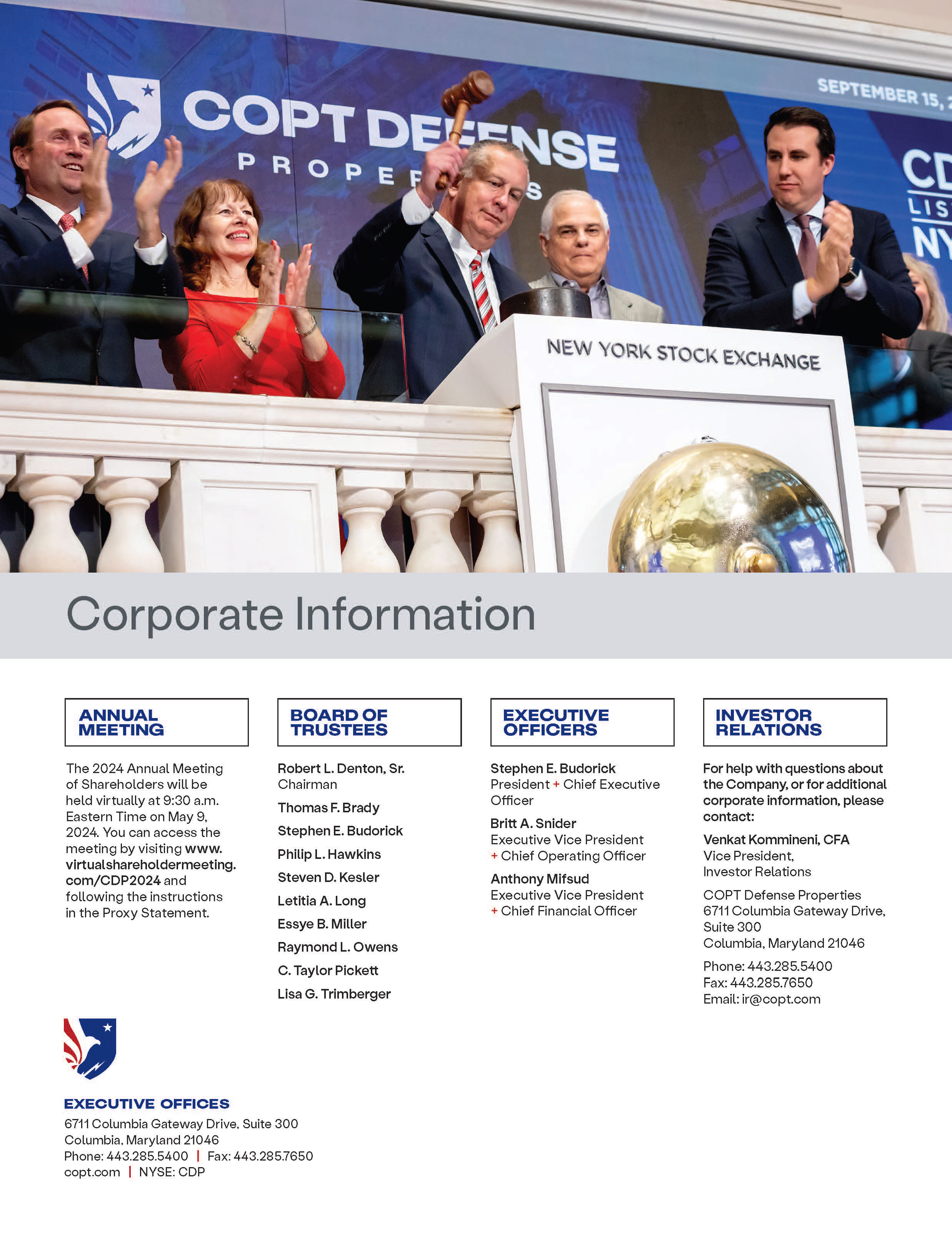
VOTE BY INTERNET - www.proxyvote.com Use the Internet to transmit your voting instructions and for electronic delivery of information up until 11:59 P.M. Eastern Time on May 9, 2018. Have your proxy card in hand when you access the web site and follow the instructions to obtain your records and to create an electronic voting instruction form. CORPORATE OFFICE PROPERTIES TRUST 6711 COLUMBIA GATEWAY DRIVE, SUITE 300 COLUMBIA, MD 21046 ELECTRONIC DELIVERY OF FUTURE PROXY MATERIALS If you would like to reduce the costs incurred by our company in mailing proxy materials, you can consent to receiving all future proxy statements, proxy cards and annual reports electronically via e-mail or the Internet. To sign up for electronic delivery, please follow the instructions above to vote using the Internet and, when prompted, indicate that you agree to receive or access proxy materials electronically in future years. VOTE BY PHONE - 1-800-690-6903 Use any touch-tone telephone to transmit your voting instructions up until 11:59 P.M. Eastern Time May 9, 2018. Have your proxy card in hand when you call and then follow the instructions. VOTE BY MAIL Mark, sign and date your proxy card and return it in the postage-paid envelope we have provided or return it to Vote Processing, c/o Broadridge, 51 Mercedes Way, Edgewood, NY 11717. TO VOTE, MARK BLOCKS BELOW IN BLUE OR BLACK INK AS FOLLOWS: E38664-P04239 KEEP THIS PORTION FOR YOUR RECORDS DETACH AND RETURN THIS PORTION ONLY THIS PROXY CARD IS VALID ONLY WHEN SIGNED AND DATED. CORPORATE OFFICE PROPERTIES TRUST The Board of Trustees recommends that you vote "FOR" the listed nominees: 1. Election of Trustees Nominees: For ! ! ! ! ! ! ! ! Against ! ! ! ! ! ! ! ! Abstain ! ! ! ! ! ! ! ! 1a) Thomas F. Brady The Board of Trustees recommends you vote "FOR" Proposals 2, 3 and 4. 1b) Stephen E. Budorick For Against Abstain 2. Ratification of the Appointment of Independent Registered Public Accounting Firm. ! ! ! ! ! ! 1c) Robert L. Denton, Sr. 1d) Philip L. Hawkins 3. Approve Amendment to Amended and Restated Declaration of Trust Granting Shareholders the Right to Approve a Merger or Business Combination by Simple Majority Vote. 1e) David M. Jacobstein ! ! ! 4. Approval, on an Advisory Basis, of Named Executive Officer Compensation. 1f) Steven D. Kesler 1g) C. Taylor Pickett NOTE: Such other business as may properly come before the meeting or any adjournment thereof. 1h) Lisa G. Trimberger ! For address changes and/or comments, please check this box and write them on the back where indicated. ! Yes ! No Please indicate if you plan to attend this meeting. Please sign exactly as your name(s) appear(s) hereon. When signing as attorney, executor, administrator, or other fiduciary, please give full title as such. Joint owners should each sign personally. All holders must sign. If a corporation or partnership, please sign in full corporate or partnership name by authorized officer. Signature [PLEASE SIGN WITHIN BOX] Date Signature (Joint Owners) DateImportant Notice Regarding the Availability of Proxy Materials for the Annual Meeting: The Notice and Proxy Statement and Annual Report are available at www.proxyvote.com. E38665-P04239 CORPORATE OFFICE PROPERTIES TRUST Annual Meeting of Shareholders May 10, 2018 9:30 AM This proxy is solicited by the Board of Trustees This proxy is solicited by the Board of Trustees for use at the Annual Meeting on May 10, 2018. The common shares held in this account or in a dividend reinvestment account will be voted as you specify on the reverse side. If no choice is specified, the proxy will be voted "FOR" each of the trustees nominated for election in Proposal 1 and "FOR" Proposals 2, 3 and 4. By signing the proxy, you revoke all prior proxies and appoint Stephen E. Budorick and Anthony Mifsud, and each of them acting in the absence of the other, with full power of substitution, to vote these shares on the matters shown on the reverse side and any other matters which may come before the Annual Meeting and all adjournments. (If you noted any Address Changes/Comments above, please mark corresponding box on the reverse side.) Continued and to be signed on reverse side Address Changes/Comments: